Exactly What to Do in Rome: Complete Guide for First Timers
Ah, Roma. Rome is a city full of so much history and culture that it makes its way onto nearly everyone’s bucket list. The challenge with Rome, and it’s one that we’ve heard over and over again, is that there is so much to do and see within the boundaries of the city that planning a trip can get overwhelming FAST.
We’ve been to Rome multiple times – including a full 10 days spent exploring Rome on our last trip to Italy (if you’re planning a trip, make sure to read our guide to planning your Italy itinerary).
While we had done the main sights in Rome before – namely, the Colosseum and the Vatican – that much time gave us enough space to get a level deeper and explore the parts of Rome that most tourists never see.
Plus, even though it was a long, long time ago (in a galaxy…), Alysha actually lived in Rome for about six months, which gives her a slightly different perspective on the city than most.
She still loves to tell the story about being on a late night bus with a couple of drunk Americans, and having a group of Italians mistake her for Italian herself and speak to her in Italian, ridiculing the dumb Americans (luckily, she speaks Italian).
We firmly believe that the best way to experience Rome is not to spend your entire time rushing around the city from one site to the next. Yes, of course you want to see the Colosseum and the Vatican with St. Peter’s Basilica.
But we also think that the best way to do Rome is to save time in between those main tourist attractions for exploring on foot, wandering, and enjoying a slow lunch or dinner on an outdoor terrace.
In this guide to what to do in Rome, we’re not going to give you a list of every single museum, park, piazza, and church that you could possibly see in Rome.
Instead, we’ll give you a blend of the main attractions in Rome – what they are, some brief historical context, and how to see them – but we’ll also give you some of our other favorite things to do in Rome.
Which, to be honest, is mostly eating and drinking, with a few magnificent views of the Eternal City sprinkled in for good measure.
Armed with that (and our guide to planning a Rome itinerary), you’ll be ready to plan a trip that will go a level deeper than most and learn about the different aspects of Rome’s history and culture that have shaped the city as we know it today over the several millennia it has been in existence.
Learning is our favorite part of travel, which you’ll probably realize as you read this.
Sound good to you? Let’s get into the best things to do in Rome.
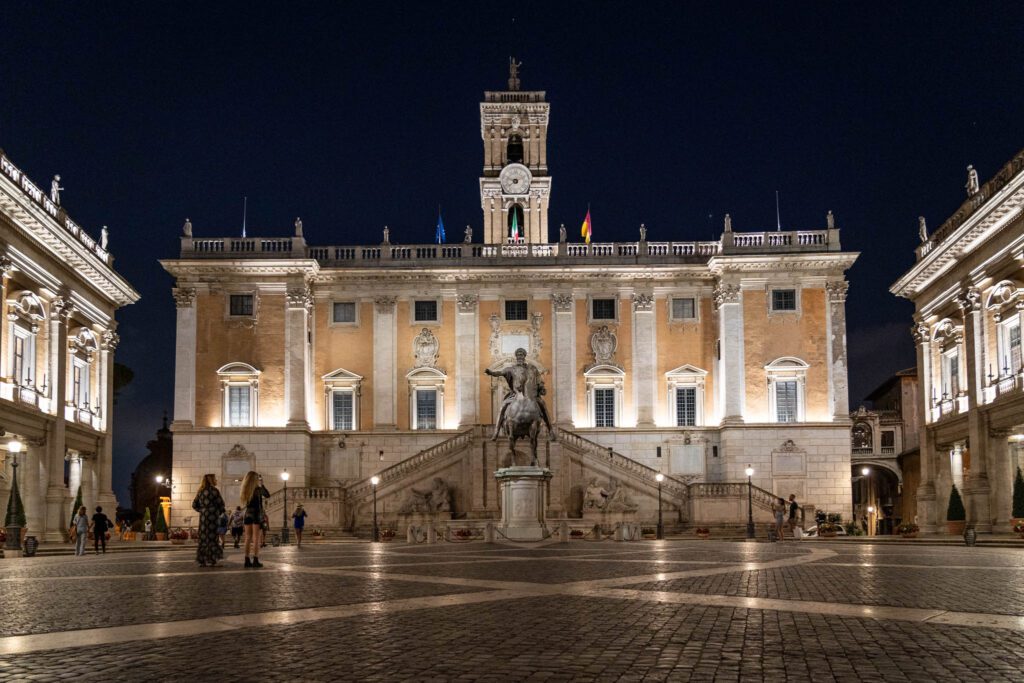

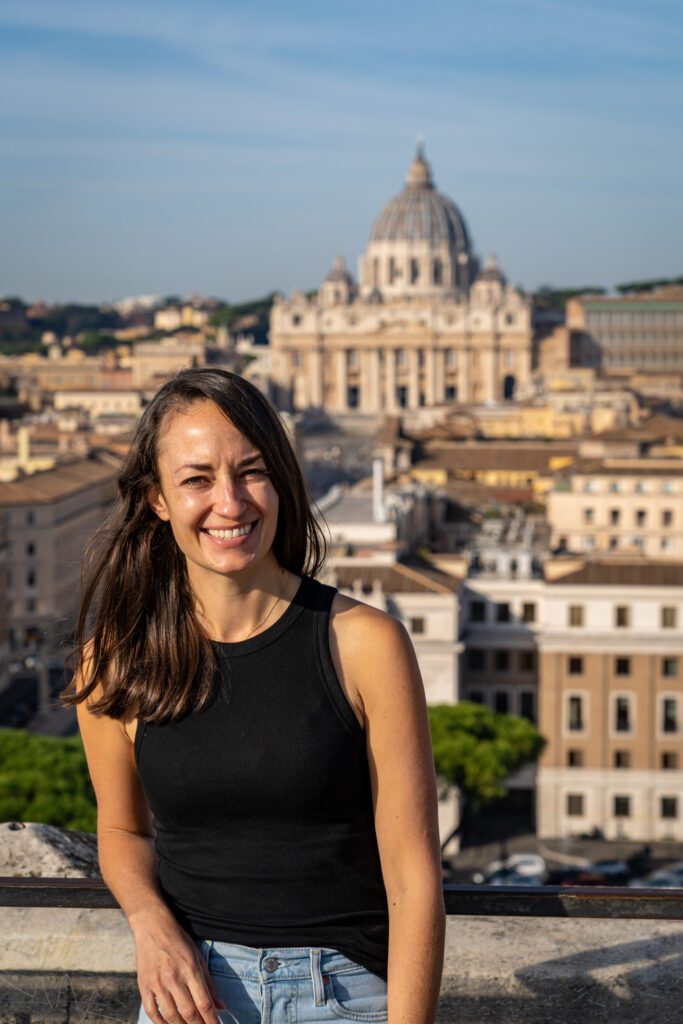
Disclaimer: Some of the links in this post, like hotel links, are affiliate links, meaning at no additional cost to you, we make a little bit of money if you click through and book. That being said, we would never recommend something to you that we don’t stand behind 100%.
What to Do in Rome: The Best Things to Do and See in Rome
We have this guide broken up into four sections. They are:
- The Main Sights in Rome
- Other Things in Rome That We Love
- Eating and Drinking in Rome
- The Best Views in Rome
Below that, you’ll find some practical information on when to visit and where to stay for your trip.
The Main Sights in Rome: The Colosseum, Vatican, and Centro Storico
Look, we get it. When you visit Rome for the first time, you’re definitely going to want to see the main sights that everyone talks about – the Colosseum and Roman Forum, the Vatican and St. Peter’s, and the Centro Storico.
The thing we want to make super duper clear is that we think that shouldn’t be the only thing you do while you’re in Rome.
We also think it’s important to consider how you want to experience each of the main sights. Which is why we have detailed guides below that include our recommendations on how best to tackle each sight to get the most from the experience.
Whatever you do, make sure to save time for the other stuff – the food, the views, soaking up the atmosphere – in between these main sights.
The Colosseum & Roman Forum
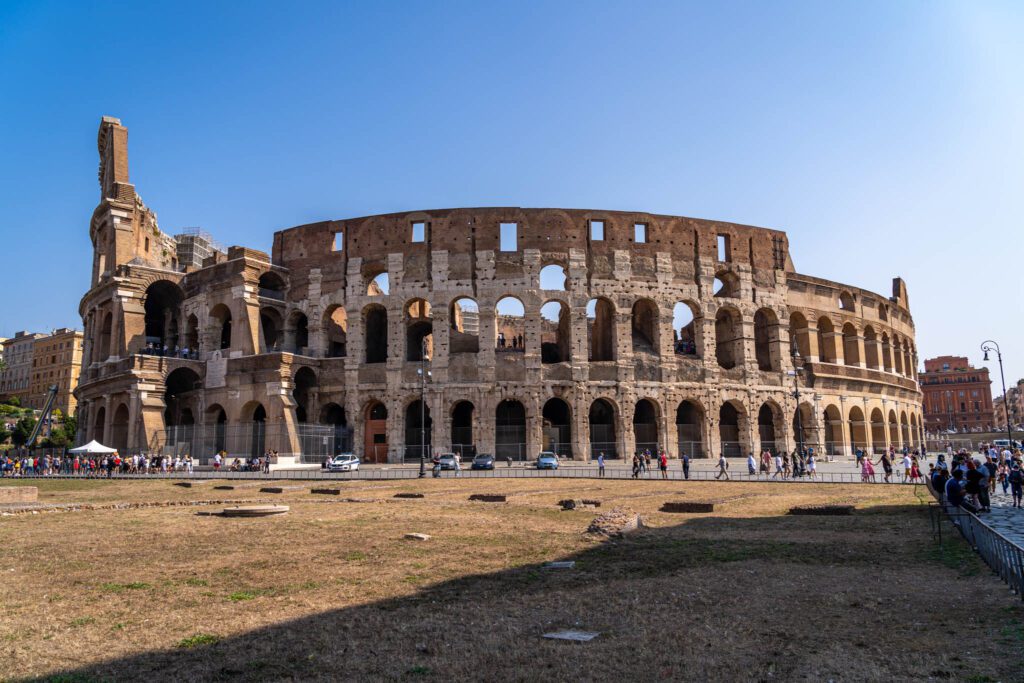
This is the heart of Ancient Rome, at least in our minds. Coming from an American perspective – particularly being from the west coast, where our cities are MAYBE 200 years old – the depth of history and culture that exists within this little complex is mind boggling.
Thousands and thousands of years old, some of the structures have been repaired, sure, but the fact that anything at all is standing here after millenia brings the grandeur and impressiveness of the Roman empire into full focus.
Some guides will have these broken apart, and I totally understand why. They’re completely different experiences, and represent very different things in Roman history.
However, we feel like it makes the most sense to visit them both at the same time, which is why we’re including both under one heading.
Before or after your visit, there’s an excellent view of the Roman Forum from OUTSIDE the boundaries located here.
We have personally done (and enjoyed) TakeWalks’ Skip the Line: Premium Colosseum Tour with Roman Forum & Palatine Hill – you can read about our experience here (spoiler: we loved it!). It is a great tour option that includes both the Colosseum and Forum.
The Colosseum
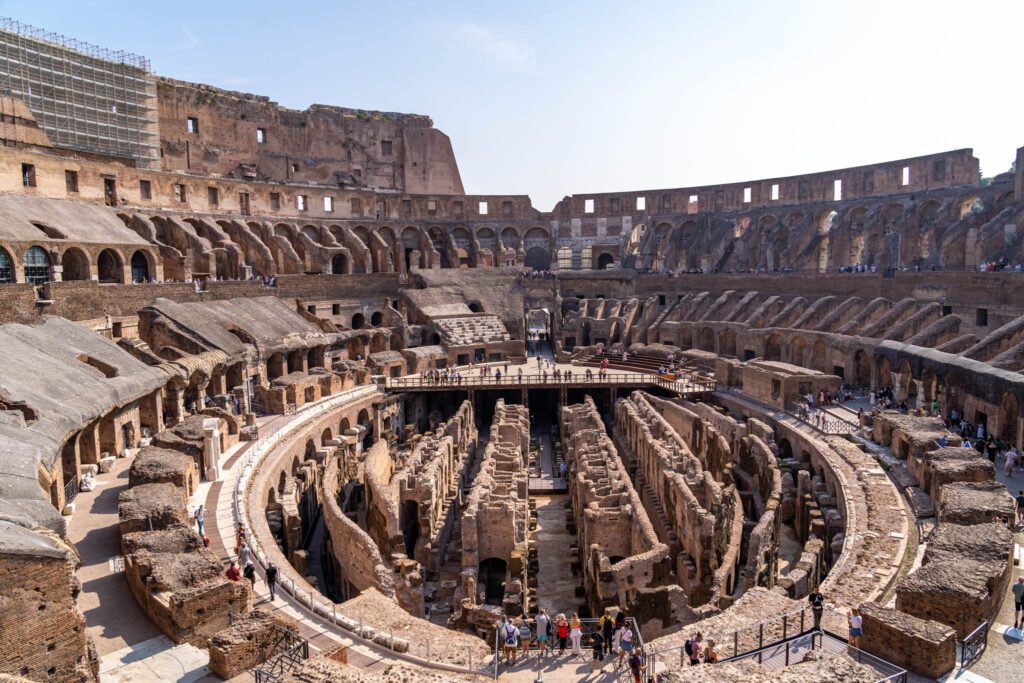
The Colosseum is the massive Roman amphitheater, the most well-known (and biggest) in the world.
The structure was commissioned by Emperor Vespasian in 72 C.E. after the area was used as a private palace for infamous (and unpopular) Emperor Nero. It was kind of a gesture to the people that the ruling class hadn’t forgotten them.
Unfortunately, Vespasian didn’t live to see it completed. Instead, it was completed under his son Titus in 80 C.E., taking just eight years to build (which is insane when you consider that some churches take several centuries).
It’s most likely that the building, after some expansions and renovations over the years, could fit somewhere between 40,000 and 50,000 spectators, though you’ll still hear numbers as high as 80,000 thrown around which most historians agree is a little aggressive.
Another misconception about the Colosseum that is mostly perpetuated by media like movies and TV shows is that the gladiatorial games were brutal, bloody, and murderous.
That’s true to an extent, but our guide reminded us that, at the end of the day, the gladiators were highly skilled professionals AND they were the property of rich people who most definitely didn’t want their assets killed.
It’s more likely that the gladiatorial battles were similar to modern-day boxing matches than the bloodbaths you’ve seen Russell Crowe participate in.
It’s massive, and it’s an incredible feat of human ingenuity. I, Matt, have done the Colosseum four different times now, and each time my jaw hits the floor as you emerge onto the platform around the edge of the arena.
The Roman Forum
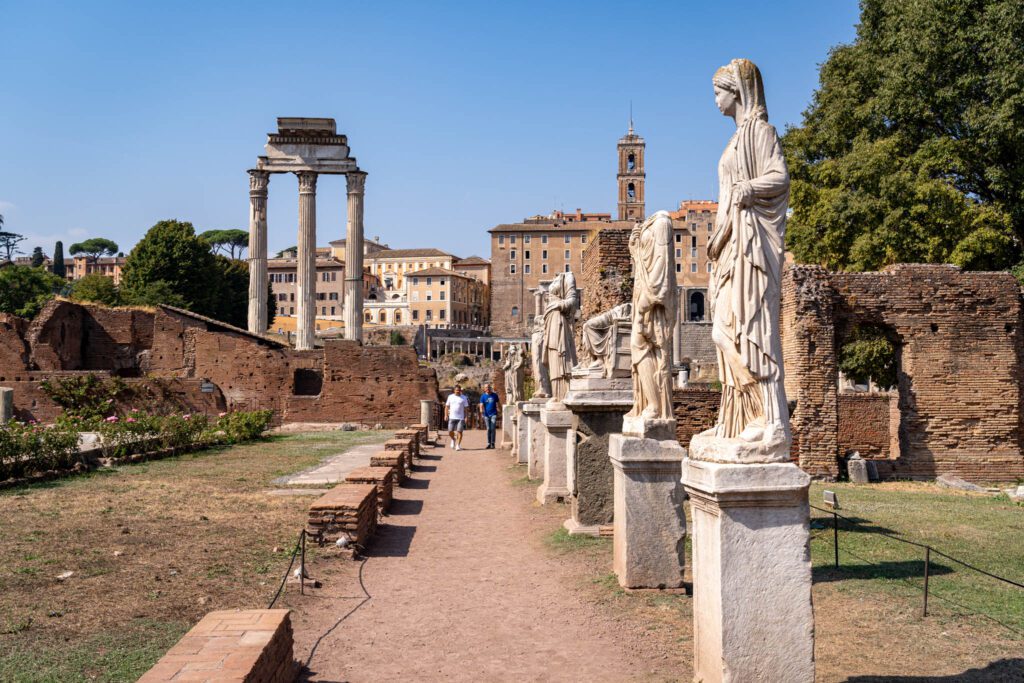
The Roman Forum – known in Italian as the Foro Romano – is a little different than the Colosseum. Unlike the Colosseum, which stands tall and intact (having been rebuilt and renovated over the years), the Roman Forum is mostly ruins.
Which makes it hard to understand what you’re looking at without a guide to help you decipher the difference between the Senate building and the Temple of the Vestal Virgins.
Palatine Hill, one of the seven hills of Rome, is just to the southwest and is accessible from within the complex (you’ll find one of the best views in Rome from the viewpoint at the top).
This is the heart of the ancient city of Rome.
The majority of the important buildings in Ancient Rome were within walking distance of this historic meeting place.
Contrary to popular belief, while there is a temple dedicated to Julius Caesar here, he was actually not killed in the Forum, but over near Largo di Torre Argentina.
How to Experience the Colosseum and Roman Forum
We have a strong opinion here, mostly informed by the fact that we did an amazing tour of the Colosseum with our favorite Italian tour compamy(you can read all about it here) where we learned that some (really, most) of the things we thought we knew about the Colosseum were actually just fairy tales.
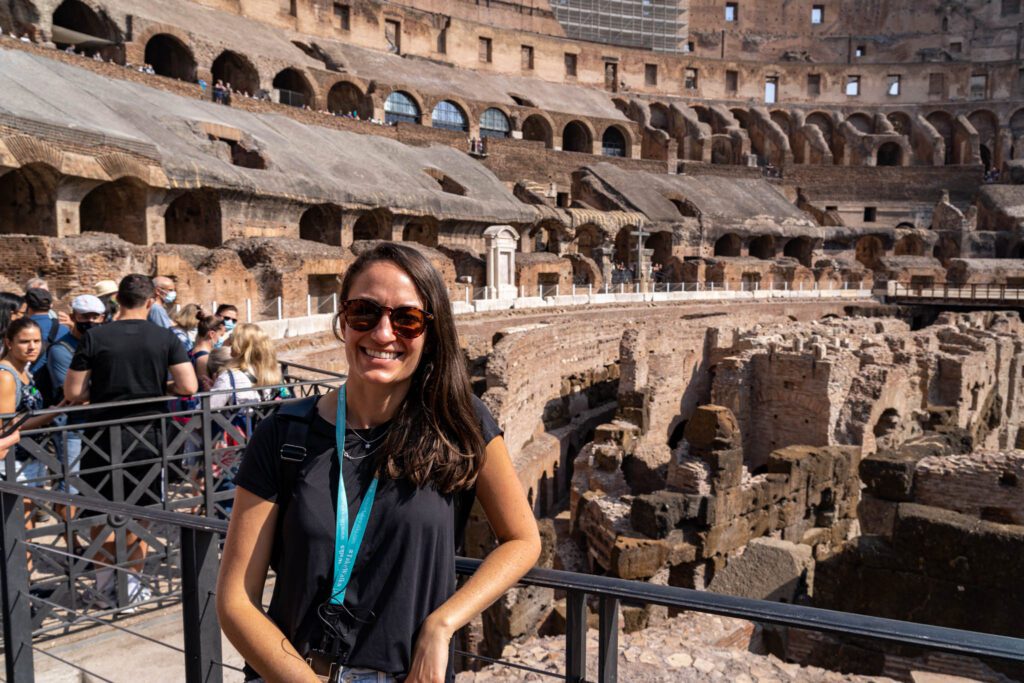
No, the battles weren’t gruesome and bloody. No, they didn’t execute Christians en masse. No, they didn’t have naval battles inside the Colosseum.
The richness of the detail and context our guide was able to bring to our understanding took the experience to the next level for us, and we’d highly, highly recommend investing in a tour.
Without those stories, it’s hard to understand the significance of what you’re seeing, especially in the Forum, which is mostly ruins at this point.
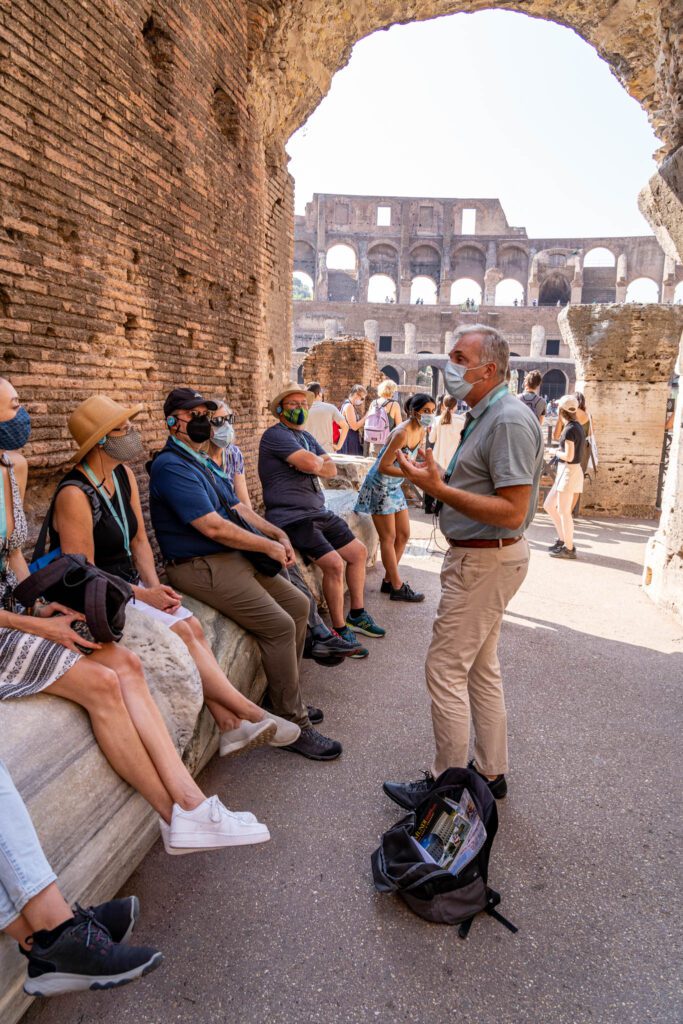
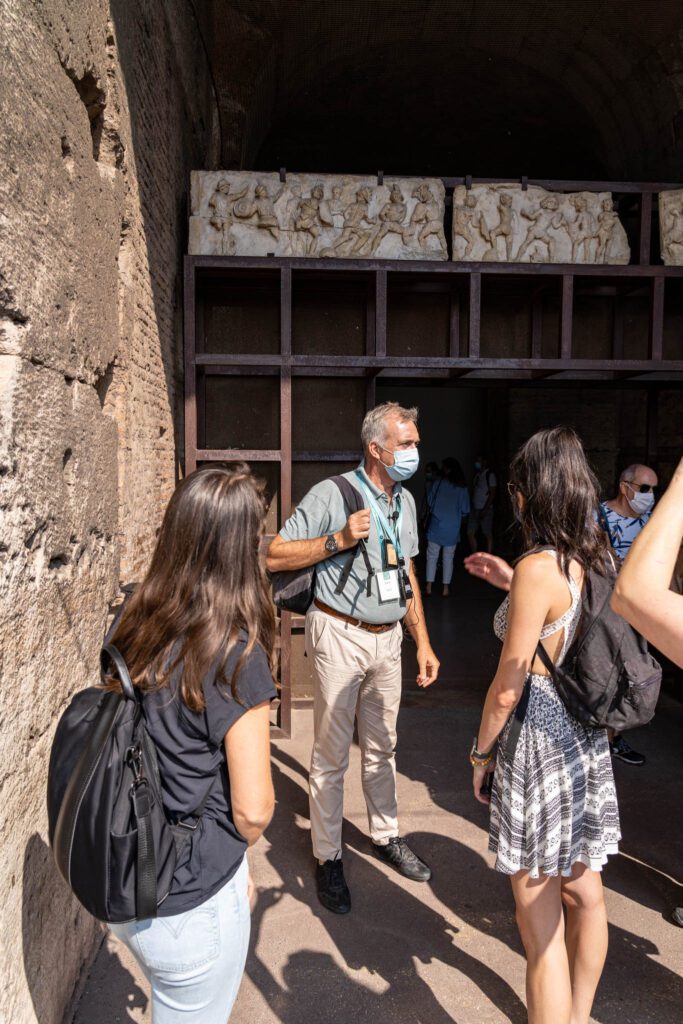
Remember, we had both experienced the Colosseum before. MULTIPLE TIMES. That, my friends, is the power of taking a tour with a guide who actually knows what they’re talking about. You’ll get to go a level deeper and learn about the structure beyond the fairy tales and myths that have been perpetuated for decades.
Now, if you’re interested in a tour, the options are a little bit confusing. Do you need to see the Colosseum floor? What about the night tour?
Lucky for you, we’ve done most of the different kinds of tours (and talked to the tour guides to get their perspective on the best version), so we’re going to break it down for you right here.
There are basically three tour options we’d consider. They all include both the Colosseum and Forum (some include bonus visits to restricted sections), and all are with an expert guide who will help bring the hulking structures to life.
The Colosseum by Day (VIP Tour): This is the tour we did, and it was fantastic. I can imagine that in the peak summer heat, the portion in the Forum where there’s little shade might be a little intense, but the information our guide gave us was truly incredible, and arguably changed some of our perspectives and opinions about Rome and Italy. You’ll cover both the Colosseum and Forum, spending the most time inside the Colosseum, with plenty of time for both pictures and questions.
The Colosseum and the Gladiator’s Gate: This tour is essentially the same as the one above – they meet at the same place, at the same time, and cover roughly the same ground. The difference is that you get to enter the arena through the Gladiator’s Gate, and walk on the reconstructed arena floor. It’s a little more expensive, but the perspective from the arena floor is otherworldly, so it might be worth it depending on what your budget looks like.
The Colosseum at Night (+ Underground Tour): We also did the night tour of the Colosseum on our latest trip, and to be honest, had a mixed experience. The tour itself is great – you’ll start outside of the Colosseum complex and walk from the Teatro di Marcello, past Piazza del Campidoglio, and down into the Imperial Forum before you get to the Colosseum. That gives you the opportunity to learn more about the Roman Empire and get some context in place before entering the Colosseum. Plus, the way the tours are spaced out once you’re in the Colosseum, you’re basically alone, which is certainly not the case during the day. You also get to explore the underground portion of the Colosseum, where gladiators and animals waited for their turn to rise to the floor of the arena, which is pretty cool, and you end the tour on the floor of the Colosseum. Unfortunately, our guide for this one was talking about the myths as if they were fact, and in general was just not up to the task of answering questions and bringing historical knowledge to the group. All tours are heavily dependent on the guide, so we’d still recommend this tour because of the experience of seeing the Colosseum from a completely different perspective.
Visiting the Colosseum and Forum on Your Own
Want to visit on your own? We’d highly recommend downloading the Rick Steves audio guide, which I’ve used before. You’ll need to bring headphones to listen to it, and it’s a way to imitate a guided tour, but for free.
Buy your tickets in advance, and as far in advance as possible if you’re coming to Rome in the summer. For more information and to buy tickets, go to the official website (we’re not giving you exact hours and ticket prices because they do change, and it’s better to just go to the official site to check them in real time).
You’re going to need at least three to four hours to do them both justice. Even in late September, exploring the Roman Forum was HOT.
In the summertime, it will be borderline unbearable with very limited opportunities for shade and a brief respite from the sun. Bring plenty of water and sunscreen, you will need both.
The Vatican Museums, The Sistine Chapel, and St. Peter’s Basilica
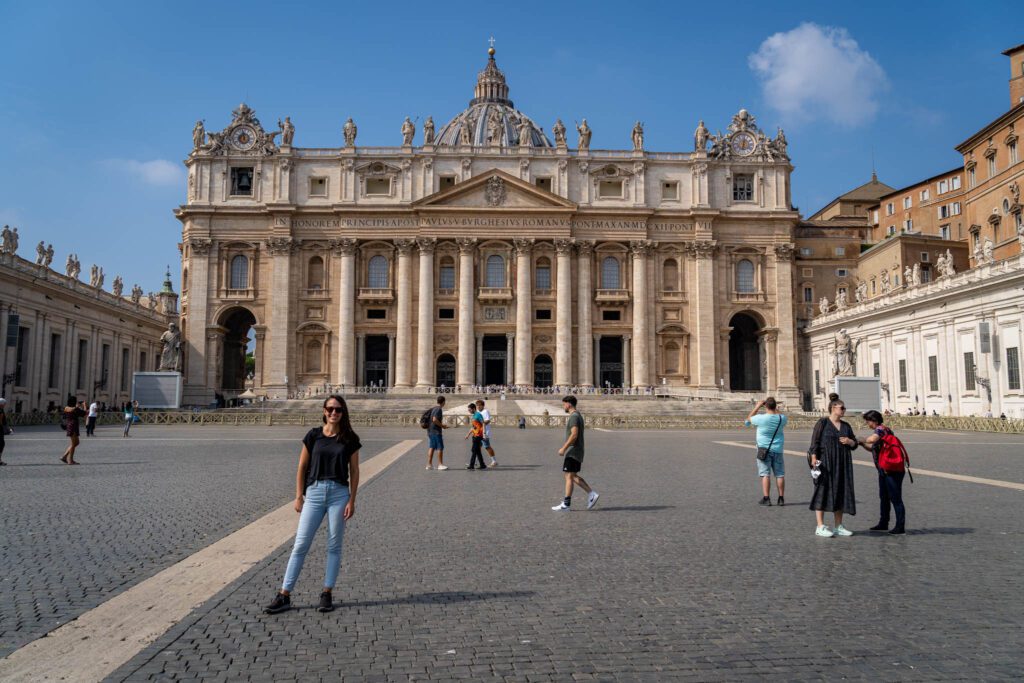
Arguably the most famous museum in the world makes its home in the collections of the Vatican. They show a whopping 20,000 pieces of art and culminate with the legendary Sistine Chapel, where the ceiling frescos bear the work of Michelangelo.
One contradiction that always pops up in the back of my mind when visiting huge, ornate churches has to do with the role of the church.
Why, you might ask, does an organization that preaches the Bible, which unequivocally condemns rich people who do not give away their wealth, have such an ornate and over-the-top display of wealth?
Great question to ask the Pope, if you run into him (or her, in case you’re reading this at a time when we’ve gotten a female pope).
As a religious site, I have questions about the Vatican and St. Peter’s Basilica. If you put those questions aside for a second and just consider the Vatican Museums as a collection of art, it’s a pretty incredible display featuring a who’s who of Italian art history.
There are essentially two pieces – the Vatican Museums (which include the Sistine Chapel) and St. Peter’s Basilica. You should visit both, and you should try to be either on the first or last tour of the day.
We’d also say that it’s well worth climbing the dome of St. Peter’s Basilica for a nice view out over the square below and towards Rome’s historic center, with its various churches and government buildings towering above the rest of the city.
This is another site that you should definitely buy tickets for in advance, especially during the summer. Buy tickets here – toggle the site to English with the language selector in the top right.
For the best experience, we’d recommend either picking the tickets that include an audio guide, or, even better, book a guided tour that includes a live guide.
We’d also recommend a guided tour here, but we think it’s less of a necessity than it is with the Colosseum and Forum, which really require a guide to fully enjoy and understand. We think that a guided tour is a nice-to-have, but a self-guided tour armed with an audio guide (or, again, the Rick Steves audio guide app) is probably good enough.
If you’re interested in a tour to go a level deeper, we’d go with the “Pristine Sistine” tour with Take Walks (one of our favorite tour companies in the world) which gets you into the Museums an hour before they open to the public, when you at least have a shot at experiencing the magic of the Sistine Chapel before it’s packed wall-to-wall with smelly, loud tourists, which can really ruin the vibes.
The Historic Center of Rome (The “Centro Storico”)
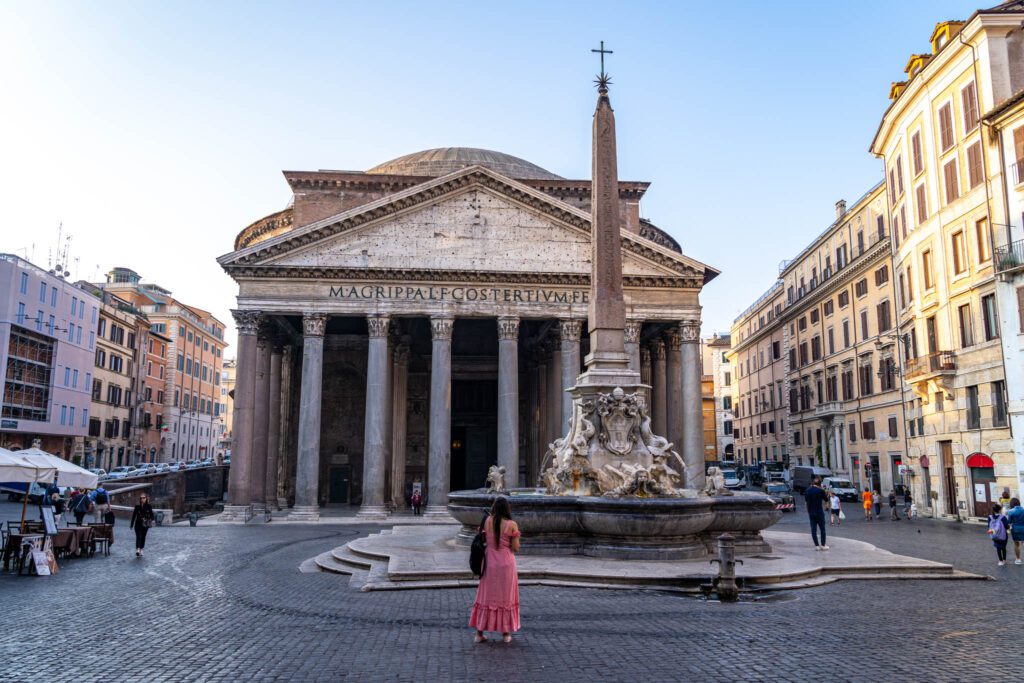
There is nothing more charming or atmospheric in Rome than walking through the city center.
However, that charm and atmosphere can be a little overwhelming in the afternoon and evening, when the narrow corridors snaking their way between the sights in the Centro Storico are crowded with people.
Instead, we’d highly recommend doing a walk through the Centro Storico (here’s a map!) early in the morning – before 9:00 am if you can – when you’ll largely have it to yourself.
You’ll start from Campo de’ Fiori, a historic square with a flower market (don’t buy souvenirs here – they’re overpriced and generally low quality), wander through the narrow alleys of Rome’s historic center, and end at the north end of the neighborhood near Villa Borghese, where you’ll be treated to an excellent view of the Vatican.
Campo de’ Fiori
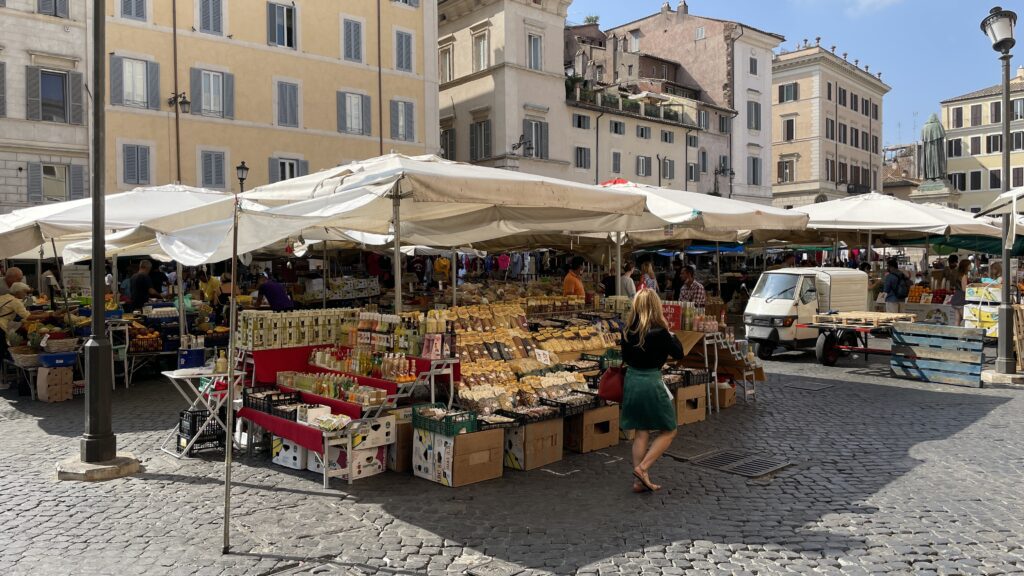
This historic square, at the southwestern end of the neighborhood just a few blocks from the Tiber, has roots in Ancient Rome. That’s where it gets it’s name – “field of flowers” – which refers to the fact that this used to be open space before the expansion of Rome swallowed it up.
Today, this square has two sides. In the morning, you’ll find a bustling market with flowers, fruits and vegetables, and the kind of over-priced, mass-produced souvenirs that you’ll find at every other shop in Rome.
In the evening, it turns into an outdoor club, basically. The restaurants and bars on the square bring outdoor tables onto the square, and it’s generally full of people eating and drinking their way through the evening (complete with plenty of “untz untz” music).
It’s a nice place to start a morning walk. If you’re looking for coffee nearby, either stop in at one of the many bakeries and cafes for an espresso at the bar, or detour a few blocks over to Barnum for specialty coffee.
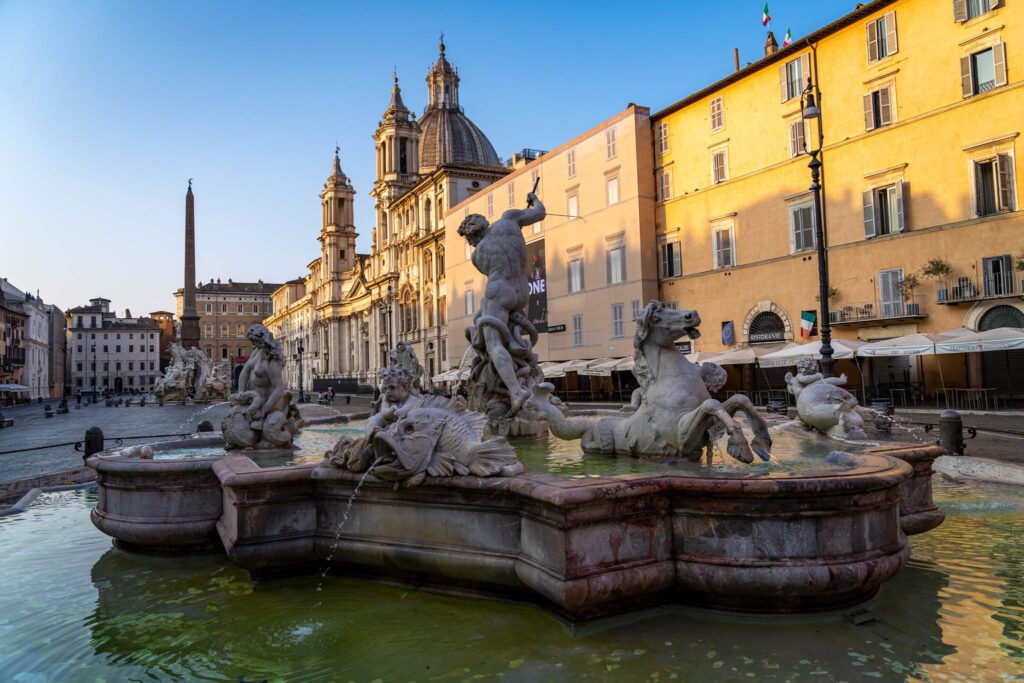
Piazza Navona is probably our favorite of the stops on this walk through the city center. It’s a huge, oval-shaped open space with a ton to see.
The shape comes from the fact that the square exists on the site of an old stadium, and it became the place it is today in the 15th Century (which explains the architectural style you’ll find here).
You’ll be approaching from the south if you’re coming from Campo de’ Fiori, so we’ll start there.
At the southern end of the square, there’s a fountain – the Fountain of Moro – with some scantily-clad, well-muscled men frolicking in the water. At the northern end is the Fountain of Neptune, which is another excuse to have a bunch of muscled half-naked men in the water, I guess.
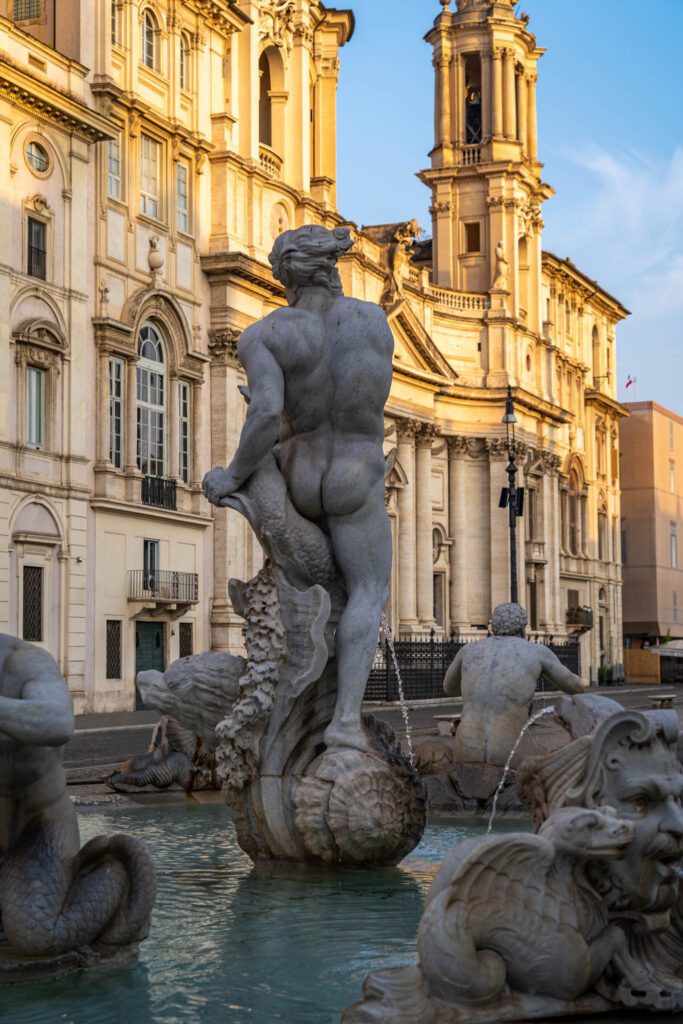
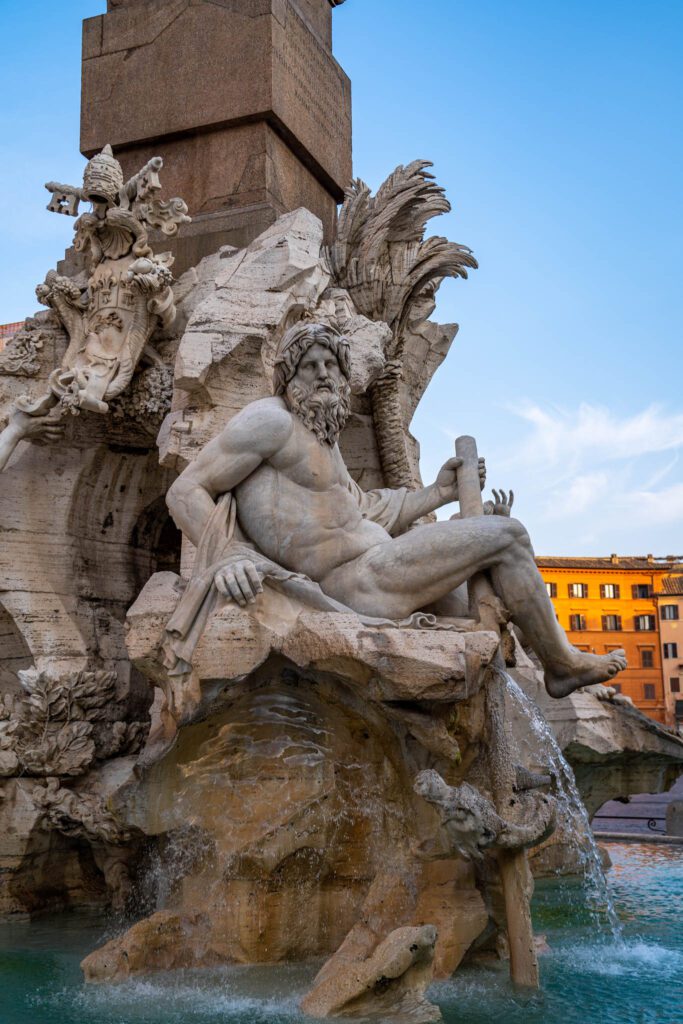
In the center is an obelisk – the Obelisk of Domitian – and just to the right there’s a massive church – Sant’Agnese – that looms over the square.
Most importantly, there’s a Grom gelato location at the northern end of the square that serves our favorite gelato in Rome (plus, everything is gluten free, including the cones, which Matt loves). Is it ever too early for gelato?
More on gelato in the “Rome for foodies” section below!
The Pantheon
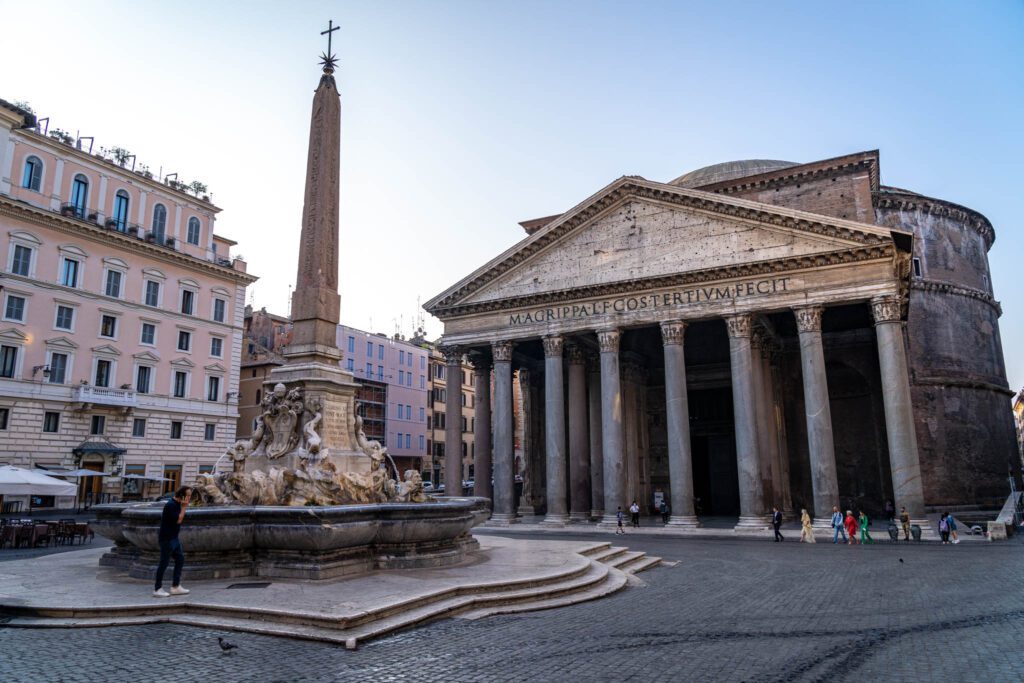
Continue your journey, turning east from Piazza Navona to make your way a few short blocks to the Pantheon.
The Pantheon – which in current times has a huge line at all hours as they have to check the Green Pass for entry – is a huge former Roman temple that was built in the second century C.E. (though a temple existed before that on the same site before it burned down).
In the 6th Century, it became a Catholic church, and as a result of their care it is one of the more intact buildings from Ancient Rome.
To be honest, we wouldn’t (and, in fact, didn’t) wait in line to go inside the temple/church. It’s cool, sure, but probably not worth waiting for more than 10 or 15 minutes.
If you do go inside, we think the intricate (and huge) dome and the skylight are the coolest parts, bringing some of that sweet Mediterranean sun into the cool darkness of the Pantheon’s interior.
For a traditional coffee experience – head over to nearby Tazza d’Oro (here on Google Maps) and order an espresso at the bar, which is a must-do experience for coffee lovers in Rome. Don’t sit down!
Order from the cashier at the front, take your receipt to the bar, and show it to the (gruff) barista. It’s cheaper and a more unique experience that way, we think.
Trevi Fountain
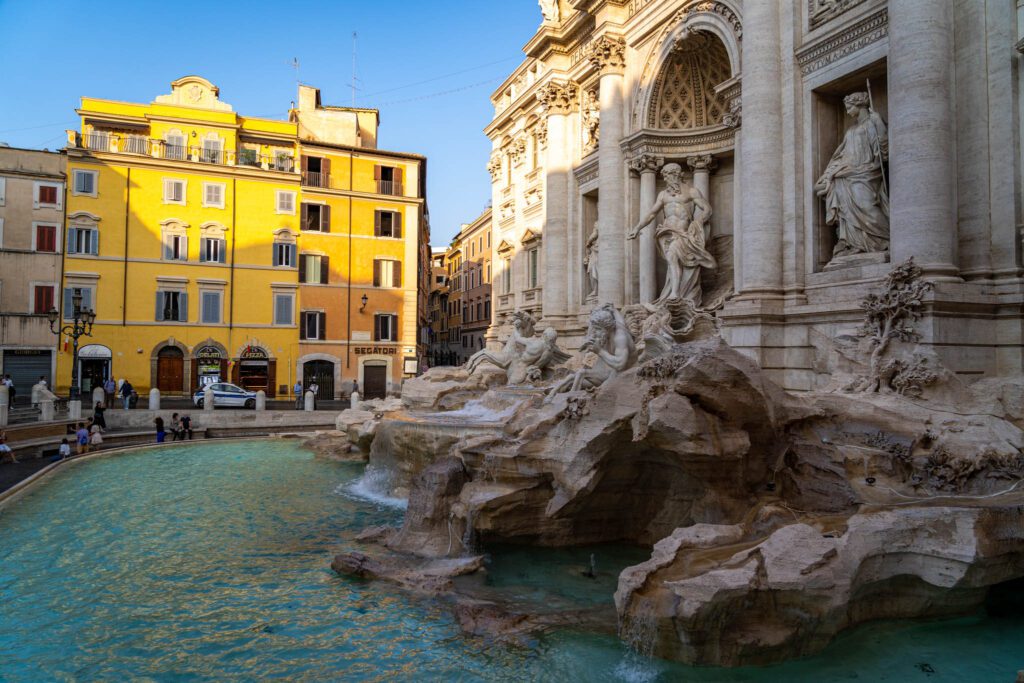
Continue the journey east to the most beautiful and the most crowded sight in the Historic Center, the Trevi Fountain.
Everyone who comes to Rome comes to Trevi to either a) throw a coin in or b) get the perfect picture in front of the fountain. As a result, this area and the surrounding few blocks is a veritable zoo at all hours, even at 8:30 am in October when we were last there.
It’s a classic landmark, sure, but there are so, so many people.
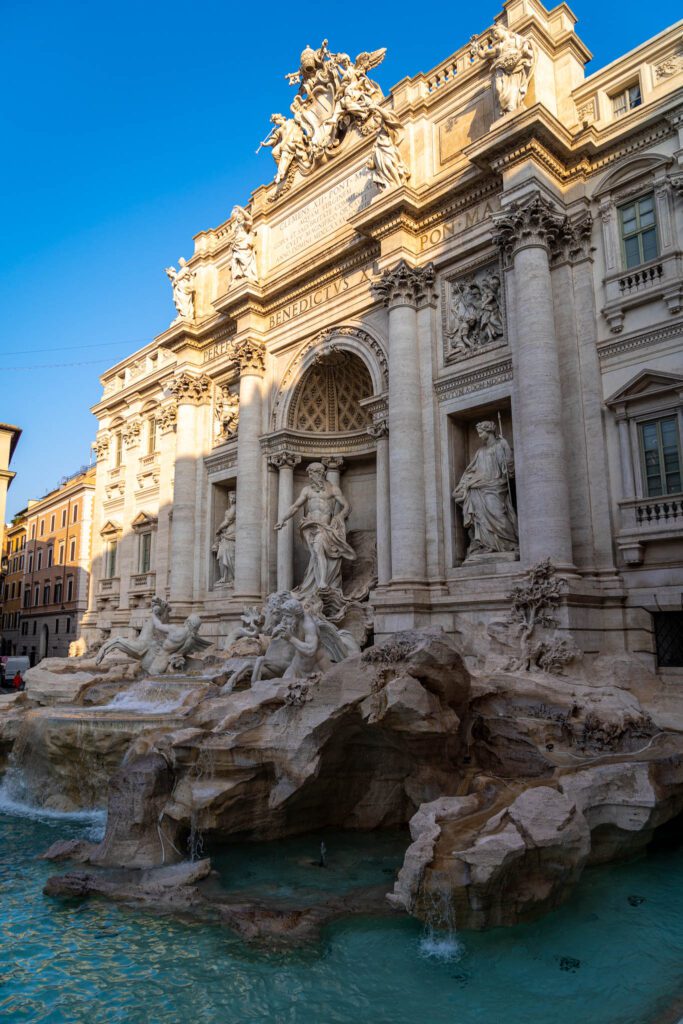
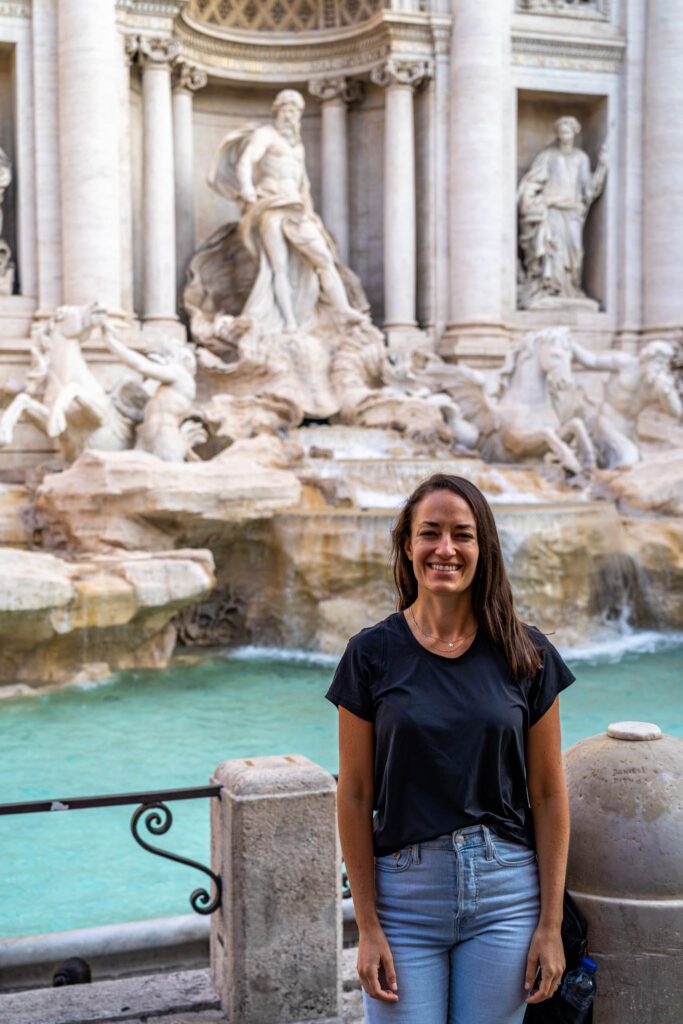
The fountain was built in the 18th Century out of Travertine stone, which, if you do a guided tour of the Colosseum and Forum, you’ll learn all about.
It’s a limestone – not a marble – that comes from quarries to the east near Tivoli (it also exists in Yellowstone National Park, I just learned), and was used for just about everything in Ancient Rome because it was relatively easy to get it to Rome.
It’s used in just about every famous structure in Rome, from St. Peter’s Basilica to the Colosseum, and pretty much everything else.
Piazza di Spagna (the Spanish Steps)
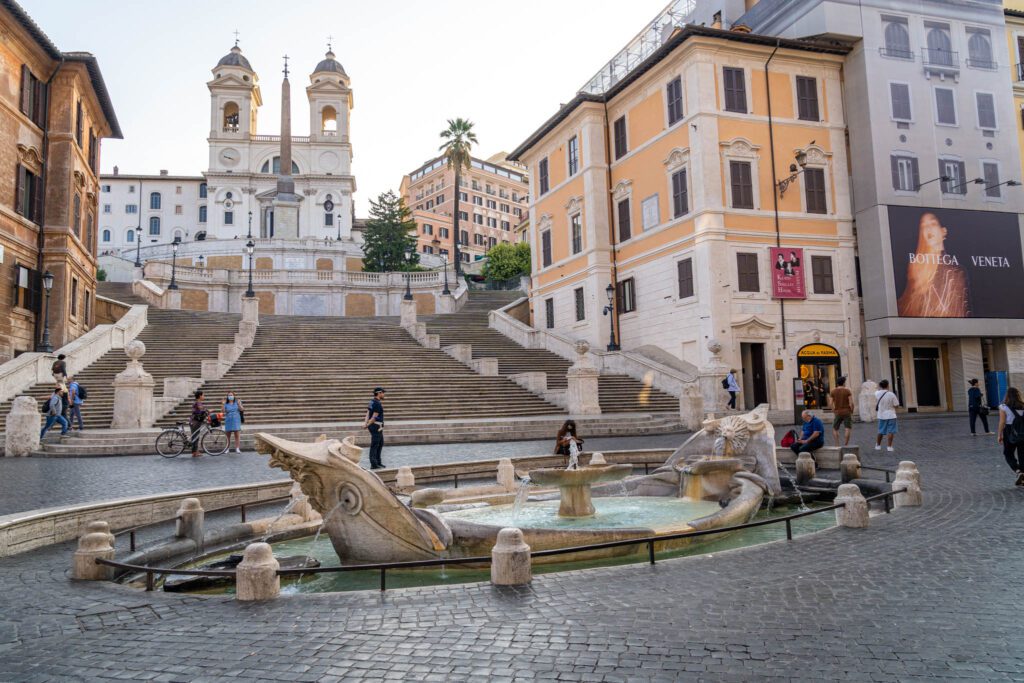
From here, your walk turns almost due north to make your way to the last stop on this grand tour, Piazza di Spagna. Or, as you might know it, the Spanish Steps.
At the base of the steps, you’ll find a baroque fountain – Fontana della Barcaccia – which depicts a longboat in the center (the name translates to “fountain of the longboat”), which is an excellent foreground subject for the steps behind it. Originally, there was supposed to be a statue of Louis XIV here, but it never came to be.
Walk up the stairs, making sure to turn around and admire the view.
If you’re up for a little more walking and want an even better view, head along the path in Villa Medici over to Terrazza del Pincio for an excellent view of the Vatican, with Piazza del Popolo in the foreground.
More Rome Travel Guides to Help You Plan Your Trip
- ITINERARY: How to Plan an Amazing Rome Itinerary
- WHERE TO STAY: The Best Places to Stay in Rome
- GLUTEN FREE: Gluten Free Restaurants in Rome
Other Things Not to Miss in Rome
Here are three more things that we think should probably be on just about every Rome itinerary.
Castel Sant’Angelo
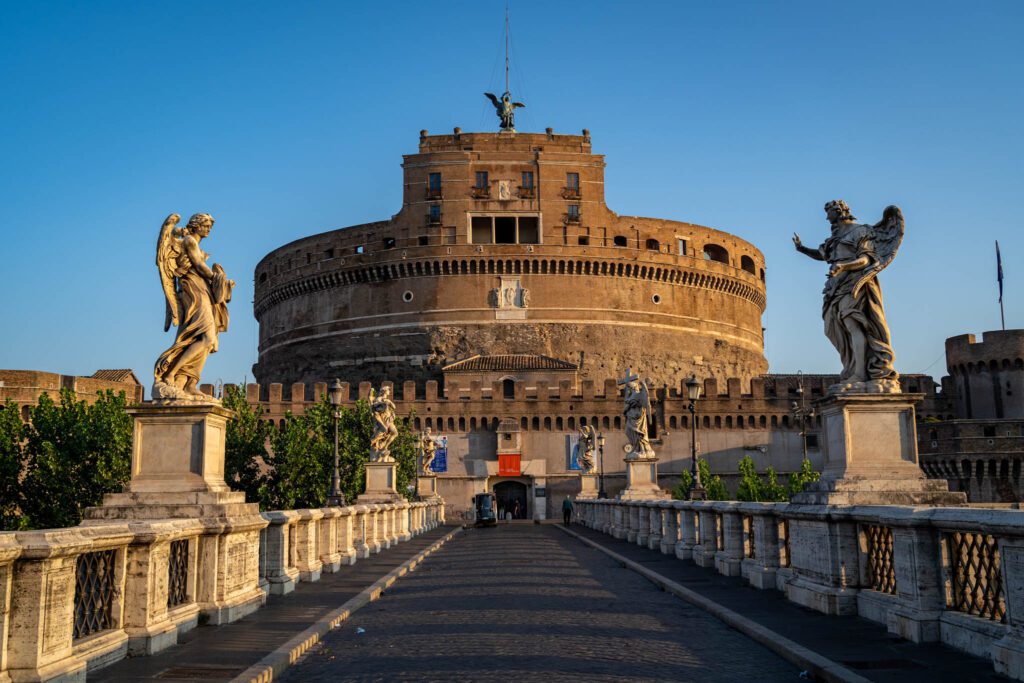
I had never actually been into Castel Sant’Angelo until our latest trip despite walking by it countless times.
The building was built as a mausoleum for Emperor Hadrian, and has been co-opted by various factions in Rome like the Catholic Church ever since (it still has the tomb of Hadrian though).
It’s actually well worth the time and money. Possibly even worth it for the view of the Vatican alone from various points on the self-guided tour they have set up.
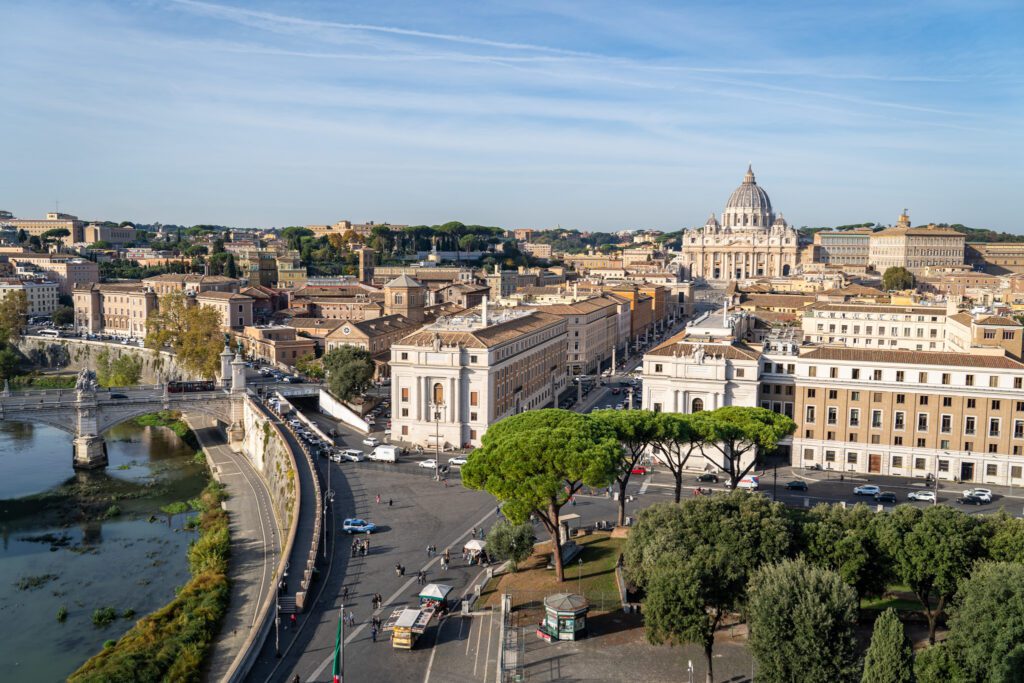
Book tickets in advance here, and try to go either first thing in the morning (when light on the Vatican is best) or last thing in the afternoon (when light on the historic center is best).
Wander Trastevere in the Afternoon / Evening
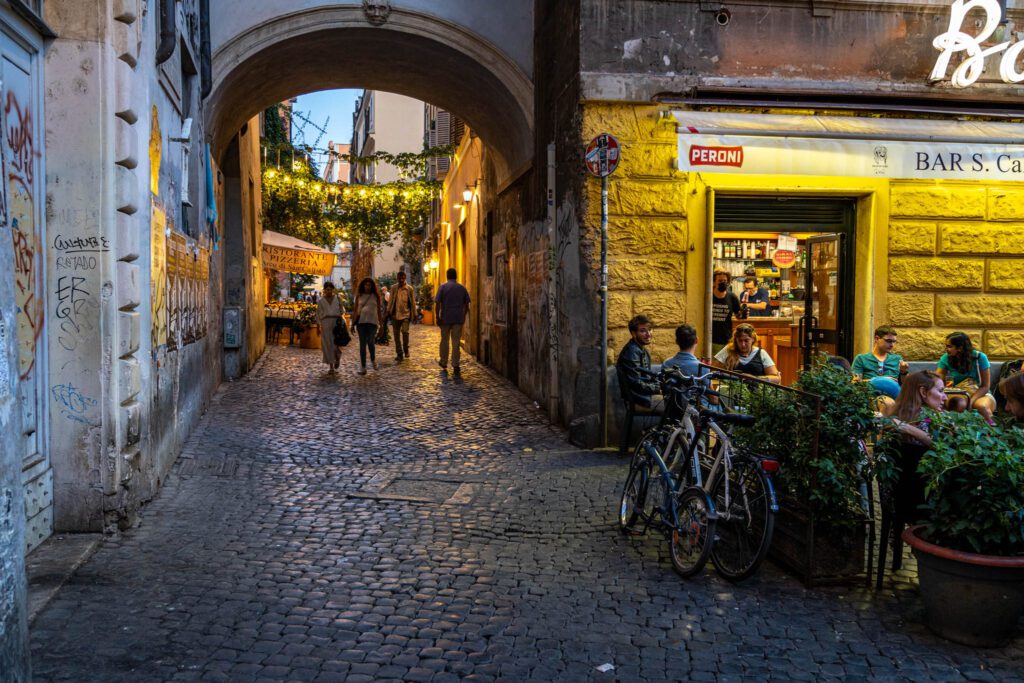
We love Trastevere at all times of day, but it really comes alive in the evening, when the people enjoying the many bars and restaurants in the area start spilling out into the streets.
Find an outdoor spot to plop down and drink a spritz or two and get to people watching – we’d suggest Freni e Frizioni, which we went to AND had recommended to us by the staff at our hotel in Trastevere.
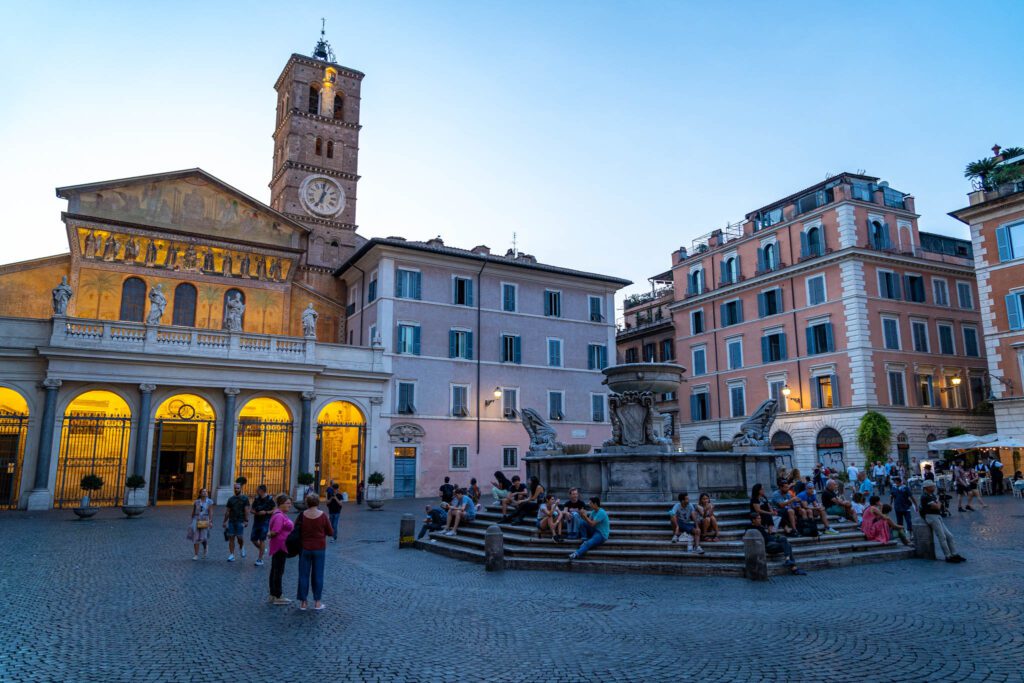
In terms of food, we enjoy Mama Eat (one of our favorite gluten free restaurants in Rome) and Fatamorgana Gelato.
Add in a walk around sunset up behind the bohemian neighborhood to Belvedere del Gianicolo for amazing views over the city, and some important history in the battle for the unification of Italy.
The Villa Borghese & Borghese Gallery
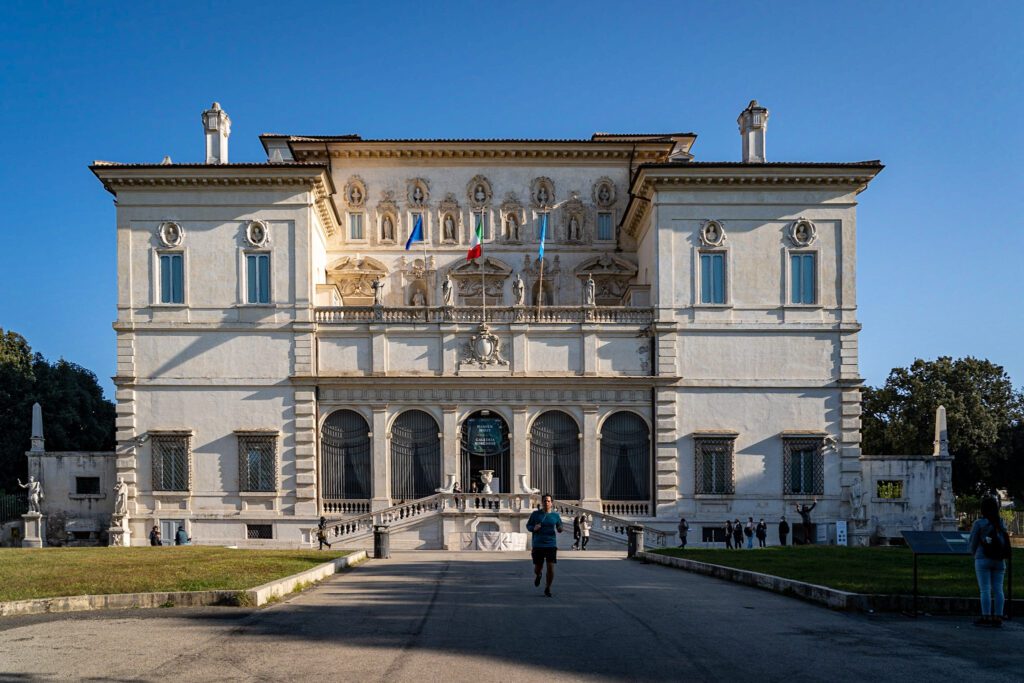
We haven’t actually done the Borghese Gallery, mostly because we’ve preferred spending our time exploring outside and have been museum-ed out. However, if you’re up for another museum and are interested in Italian art, it’s a good option and is probably the second best museum in Rome after the Vatican.
If you want to go into the Gallery, you’ll need to book tickets well in advance here as the number of entries per hour is very limited.
If they’re sold out, your other option for seeing the Borghese Gallery is a guided tour – we’d suggest this one, which includes the gardens.
The gardens, however, are well worth your time whether or not you’re up for another art museum. And they make an excellent addition to the Centro Storico walk we detailed above.
Things to Do in Rome for Foodies
Rome is an excellent food city, and we say that as two people who eat gluten free by necessity (sometimes Alysha gets to cheat, but Matt has Celiac Disease and will get deathly ill with just a crumb of gluten).
Italy happens to be a fantastic place to eat gluten free, so we largely got to eat and drink everything we wanted to while we were in Rome – gelato, simple pasta dishes (all with guanciale or pancetta), cannoli (which are Sicilian not Roman, but still very much worth eating), and things like fried artichokes and oxtail stew.
There are a bunch of different ways to experience Rome’s rich food culture (and Italy’s) while you’re in town. From food tours to cooking classes, here’s our take on what to do in Rome if you’re a foodie.
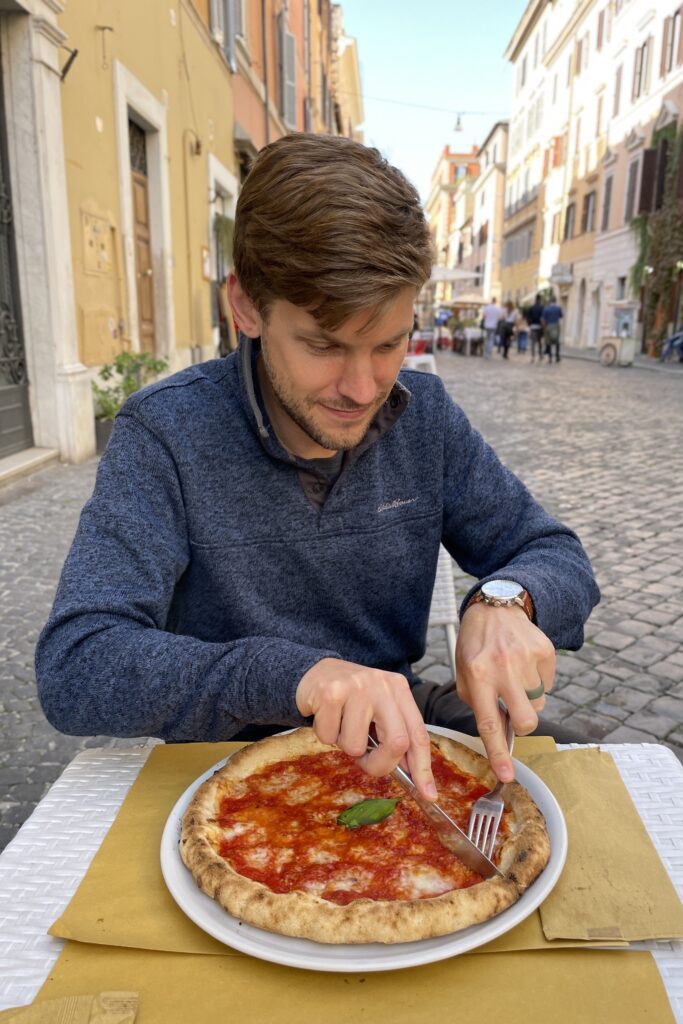
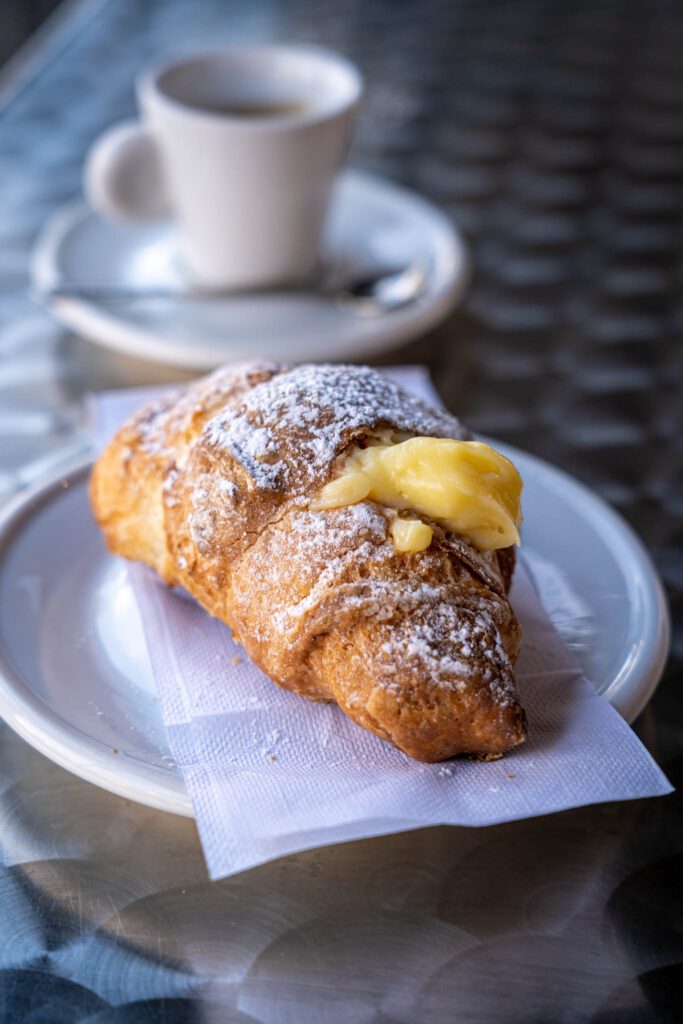
Devour ALL of the Food
First, let’s talk about what kinds of foods you should seek out when you’re in Rome.
Italian cuisine is diverse and multifaceted, and each region has a very, very different set of ingredients and, as a result, dishes that make it special.
For example, bolognese (which by the way is completely different from the Americanized version – here’s a recipe that we now make all the time and LOVE) is from Bologna and the surrounding area, while arancini (crispy fried rice balls) are a Sicilian specialty.
In Rome, the food is relatively simple. And this is most evident in the pasta dishes you’ll find in Rome, which we’ve explored at home (through this excellent cookbook) and which usually are some combination of guanciale (or pancetta), cheese, and salt and pepper.
Here are the pasta dishes that are native to Rome and are worth ordering.
Cacio e pepe: As simple as it gets. Pasta, pecorino romano cheese, salt, and pepper. No butter – the creaminess comes from the starchy pasta water added back in at the end.
Carbonara: Again, incredibly simple. Eggs, cheese, and pancetta. Add in some salt and pepper, and you’ve got a delicious, hearty, filling pasta dish. This is my first memory of a meal in Rome, and we make it all the time at home now.
Pasta alla Gricia: Take cacio e pepe and add in some guanciale and white wine.
Pasta all’Amatriciana: Take pasta alla gricia and add in tomatoes.
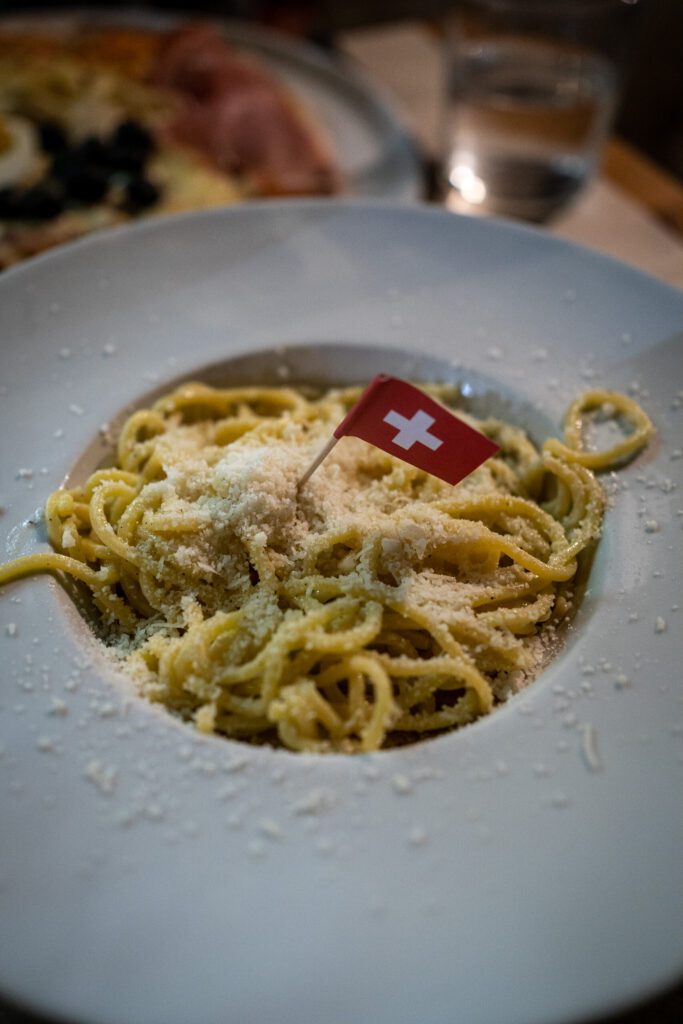
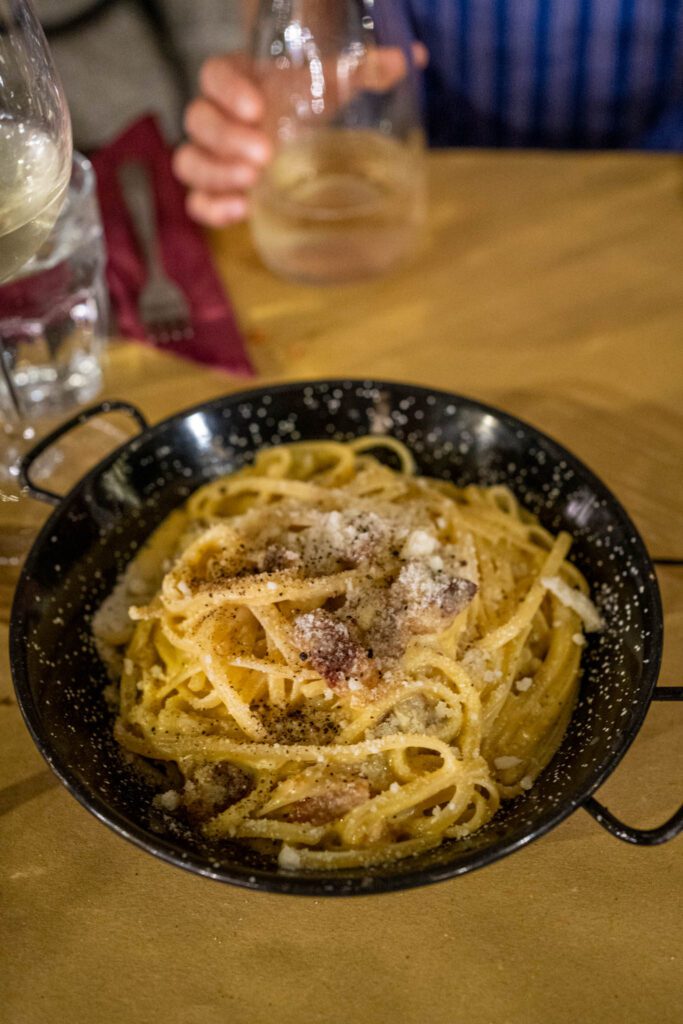
See? Super simple. And they’re all basically made with the same ingredients.
Outside of pasta, you should definitely try a few other things while you’re in Rome. We’re going to cover coffee, gelato, and wine in more detail below, so we’ll skip those categories for now.
Pizza al taglio: Pizza by the slice (New Yorkers rejoice!) usually served cut into squares. The most legendary version of this is a small shop near the Vatican, Pizzarium, though we noticed that Antico Forno Roscioli always had a line out the door (it was right under our apartment in Rome).
Anything with pecorino romano: We discovered this cheese at home as the best pasta cheese around, and it’s even better in Italy where you can get it closer to the source. It’s a hard, salty cheese, and it’s an ingredient in just about every pasta dish you’ll find in Rome.
Trippa alla Romana: Roman cuisine is pretty frugal which means you’re going to find cheaper cuts of meat around. We heard it’s because all of the good cuts of meat were taken by the nobility, which left the less desirable parts like tripe for the commoners, but we’re not sure how true that really is. This is a tomato-braised tripe with pancetta that is topped with, you guessed it, pecorino romano.
Get Your Hands Dirty and Take A Cooking Class
We LOVE doing cooking classes when we’re traveling. It’s a fantastic way to experience the local food culture (especially if there’s a guided market tour involved), meet like-minded travelers, and add a few new recipes to your repertoire at home that will remind you of your time traveling whenever you make them.
From Colombia to Mexico City to Barcelona, we’ve done cooking classes all over the world. In general, our favorites have been through Airbnb Experiences, which is now our go-to tour company because they focus on connecting you with smaller local businesses, and I truly can’t think of a bad experience we’ve had with them. Usually, they’re incredible, and are the highlight of our trip.
Now, Matt has Celiac Disease, which means no gluten for us. That means that a cooking class in Italy isn’t in the cards – too much flour flying around for Matt to be comfortable and avoid getting sick.
That, however, does not mean you shouldn’t do one.
Here are four cooking classes that would definitely be on our list if, you know, Matt could eat gluten.
- Handmade Pasta Class at the Pantheon: You’ll get a brief overview of Roman cuisine before diving in, where you’ll learn how to make two traditional kinds of pasta, along with multiple sauces. And, of course, you get to eat it. Vegetarians welcome.
- Handmade Pasta & Roman Sauces with Riccardo: We love experiences that take us to real people’s homes, in neighborhoods where most tourists don’t make it to. This is that. Join Riccardo – who was born and raised in Rome – in his family home where you’ll make handmade pasta, classic sauces like carbonara and cacio e pepe (our two favorites), and get to connect with the food culture in Rome in a really special way. Plus, wine, obviously, because this is Italy. Vegetarians welcome.
- Handmade Pasta with Grandma: Every culture has the phenomenon of “grandma cooks best,” with classic family recipes passed down from nonna to nonna, and unsurprisingly Italy is no different. You’ll make ravioli, fettuccine and farfalle – all from scratch – in their family home. Note that this tour is a bit outside of Rome (you meet here) so you’ll need to find your way there and back on the train. Vegetarians welcome.
- Pasta-Making Class – Cook, Dine & Drink Wine With A Local Chef: Hosted by TakeWalks, which we’ve already mentioned is one of our favorite tour companies in Italy, you’ll get a full rundown of handmade pasta, along with aperitivi and prosecco beforehand, and gelato for dessert. The class takes place in Trastevere. Vegetarians welcome.
Click here to see all of the cooking class options on Airbnb Experiences.
Explore Rome’s Rich Food Culture with a Food Tour
Food tours are a fantastic way to kill two birds with one stone. Those two birds being trying a bunch of amazing food, and connecting with a local who can give you the important context behind what you’re eating, give you a more personal lens into everyday life in Rome, and give you some tips and tricks for navigating Rome along the way.
Here are some food tours that caught our eye though, sadly, we also skipped these because of the whole gluten and cross-contact issue.
- Hidden Rome Food Tour in Trastevere with Dinner and Wine: Explore Trastevere – our favorite neighborhood in Rome – through the eyes of a local foodie. You’ll simultaneously taste amazing food from places that you wouldn’t have discovered on your own, and also get the background and context for how that food came to be a staple in Rome. Plus, wine and limoncello along the way! This tour combines the history and cultural aspects with great food, which is what we usually look for in a tour.
- Twilight Local Food and Hidden Places: A local born and raised, Selene and her team will take you on a tour-de-Rome’s best food. Along the way, you’ll learn about the history and culture of Rome. Followed by pizza al taglio and carbonara, among other delectable tastings. This tour covers the Centro Storico, mostly.
- The Roman Food Tour in Trastevere: This tour, which covers Prati, the neighborhood to the north of the Vatican, includes a tasting of meats and cheeses and the best pizza al taglio in Rome (which we featured below in the “Devour ALL of the food” section).
- Taste the Best of Rome (Evening Tour): 25 tastings over four hours – so you’ll want to show up hungry! You’ll meander through Prati, stopping at five locally owned spots to try a variety of delicacies from truffles, to meats and cheeses, and more.
Experience Aperitivo
Aperitivo is a period during the late afternoon, between getting off work and dinner time (which is later than you’d expect in Rome) where people go out for drinks. And those drinks are served with a selection of small bites, like bruschetta, olives, and things like that.
If you’re American or Canadian, it’s a little like happy hour, except the food is complimentary with your drinks. While the days of full-on aperitivo buffets are behind us, at least in most of Rome, the idea behind aperitivo is still one of our favorite parts about spending time in Italy.
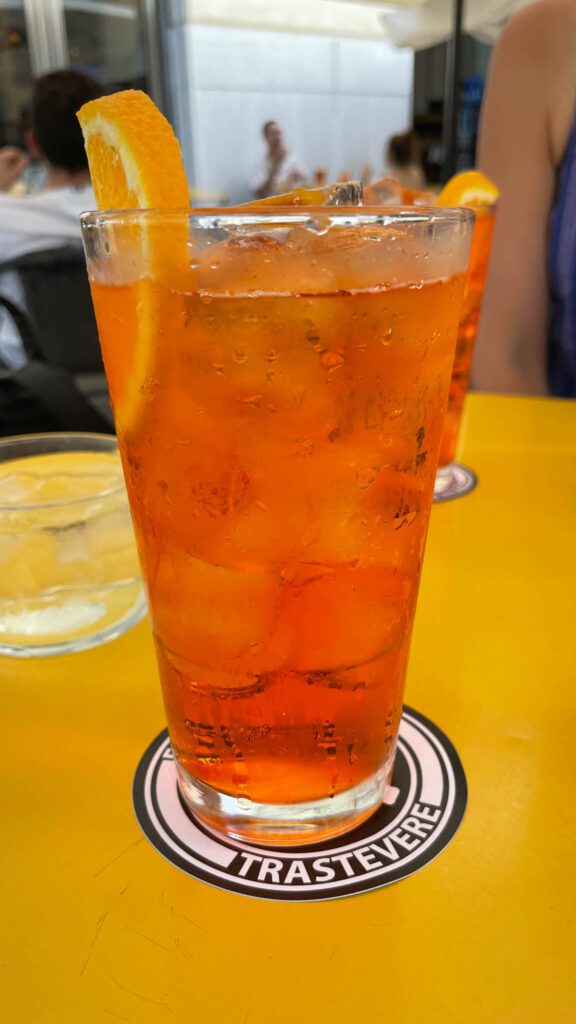
During aperitivo, our drink of choice (and what you’ll see many people drinking) is the Aperol Spritz.
It’s a light cocktail – perfect for a summer day – that is made with sparkling water, sparkling wine (all of the bubbles, please!) and Aperol, an orange-colored bitter aperitif.
Your spritz is usually going to be something like 4-5 Euros (definitely don’t pay more than 6 Euros!), and is the quintessential aperitivo beverage to us.
I made the mistake of ordering a Campari Spritz instead, just to try it, and won’t be doing it again. It was fine, totally drinkable if you’re into bitter liqueurs like Campari, but it wasn’t nearly as refreshing.
Explore Rome’s Evolving Coffee Culture
The first thing you need to know is that Matt is a full blown coffee snob. If it ain’t a light roast coffee prepared meticulously by hand, he doesn’t want it! Okay, that’s a little bit of an exaggeration. Sort of.
We spent almost two months in Italy – including a few weeks in Sicily – and because Matt wakes up every day in desperate need of a caffeine boost, we got to explore Italian coffee culture. We should really write an entire guide about it, but the gist is this.
While places like Lisbon and Paris (I linked my coffee guides for those two cities, in case you’re interested) have quickly evolving coffee scenes that have embraced specialty coffee relatively quickly, Italian coffee culture is extremely traditional – it’s espresso at the bar on your way to work with a pastry for breakfast.
It’s no cappuccinos after 10:00 am. It’s dark and bitter coffee roasted into oblivion.
I, like many Americans and Canadians traveling to Italy for the first time I imagine, have a story about ordering my first coffee in Italy. I ordered a “latte,” and the barista sniggered at me and asked me if I was sure (rather than just correcting me and helping me out). I, of course, said yes, and was promptly delivered a hot steaming glass of foamed milk.
Naturally, I ordered an espresso and dumped it in.
The truth is, I (Matt, the coffee snob here!) really enjoyed the coffee in Rome. And I think that if you’re a coffee drinker, you should definitely do the “espresso at the bar” thing at least once, even if that’s not your preferred way of drinking coffee usually.
For a taste of that “espresso at the counter” vibe, you can basically head to any cafe or bakery in Rome. But I for one really enjoyed Tazza d’Oro (right near the Pantheon) and Sant’ Eustachio Il Caffè (just east of Piazza Navona). Both were touristy, sure, but I enjoyed the experience of elbowing my way to the counter and handing the barista my receipt.
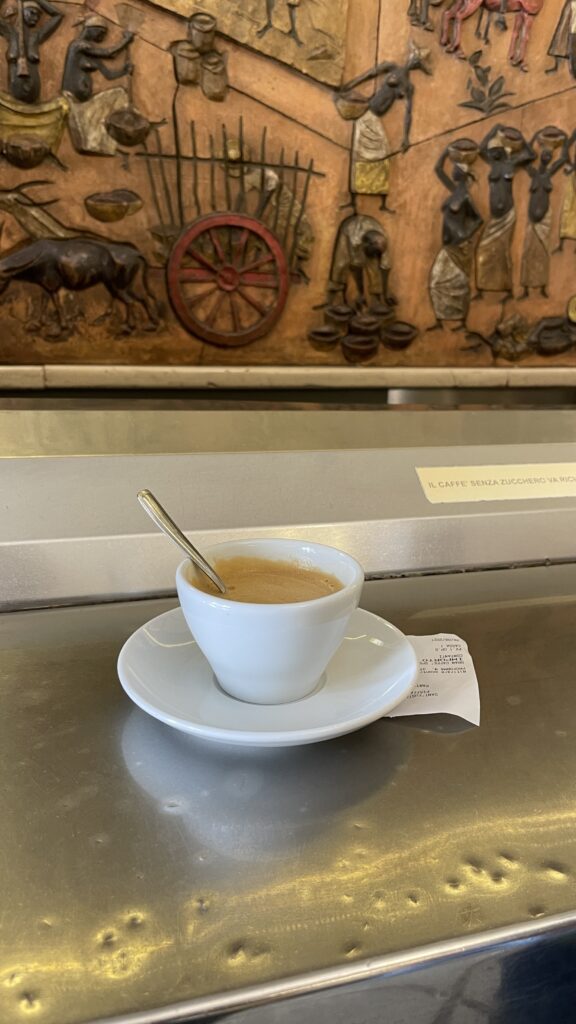
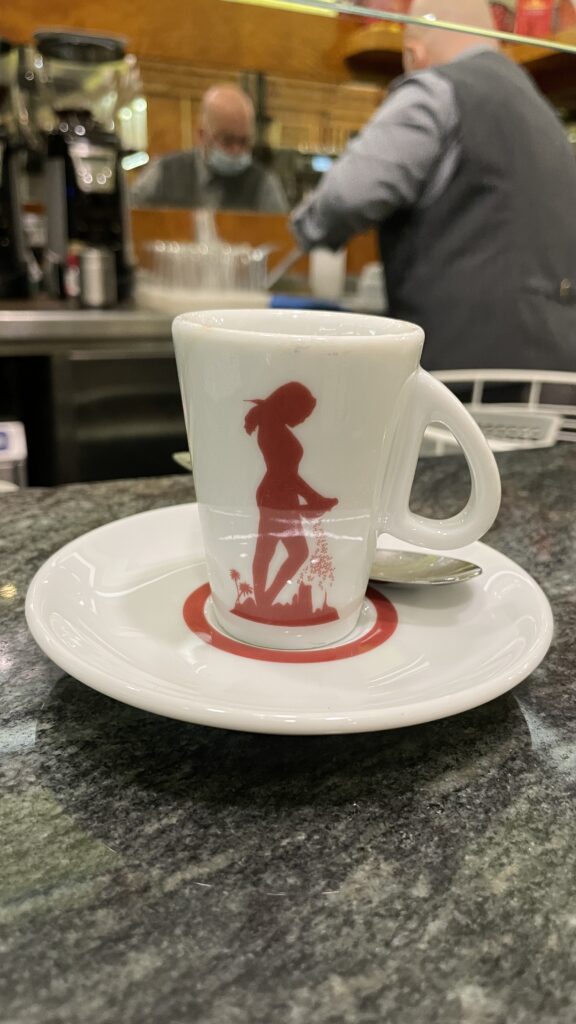
Pro-tip: The order of operations is to head to the cash register, order and pay for your drink, then take the receipt to the bar and give it to the barista. They’ll ask you – in Italian – if you want sugar or not (if you order espresso).
Another pro-tip: You’ll pay more to sit down and drink your coffee with table service than you will ordering it at the bar or to-go.
All that being said, there is a small but growing specialty coffee scene in Rome. Here are my three favorite spots.
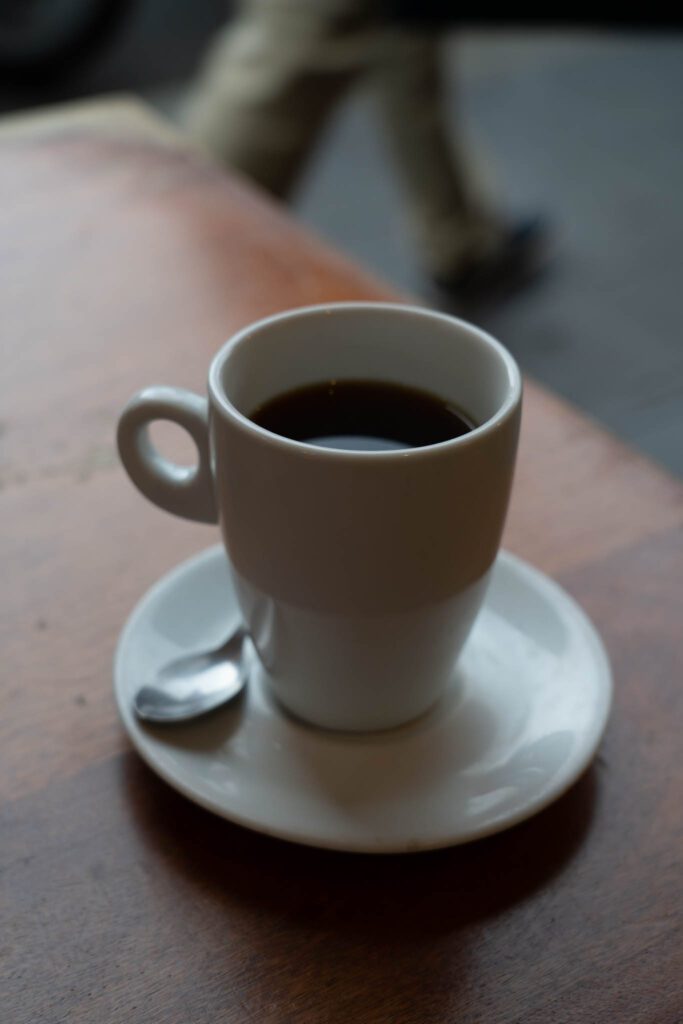
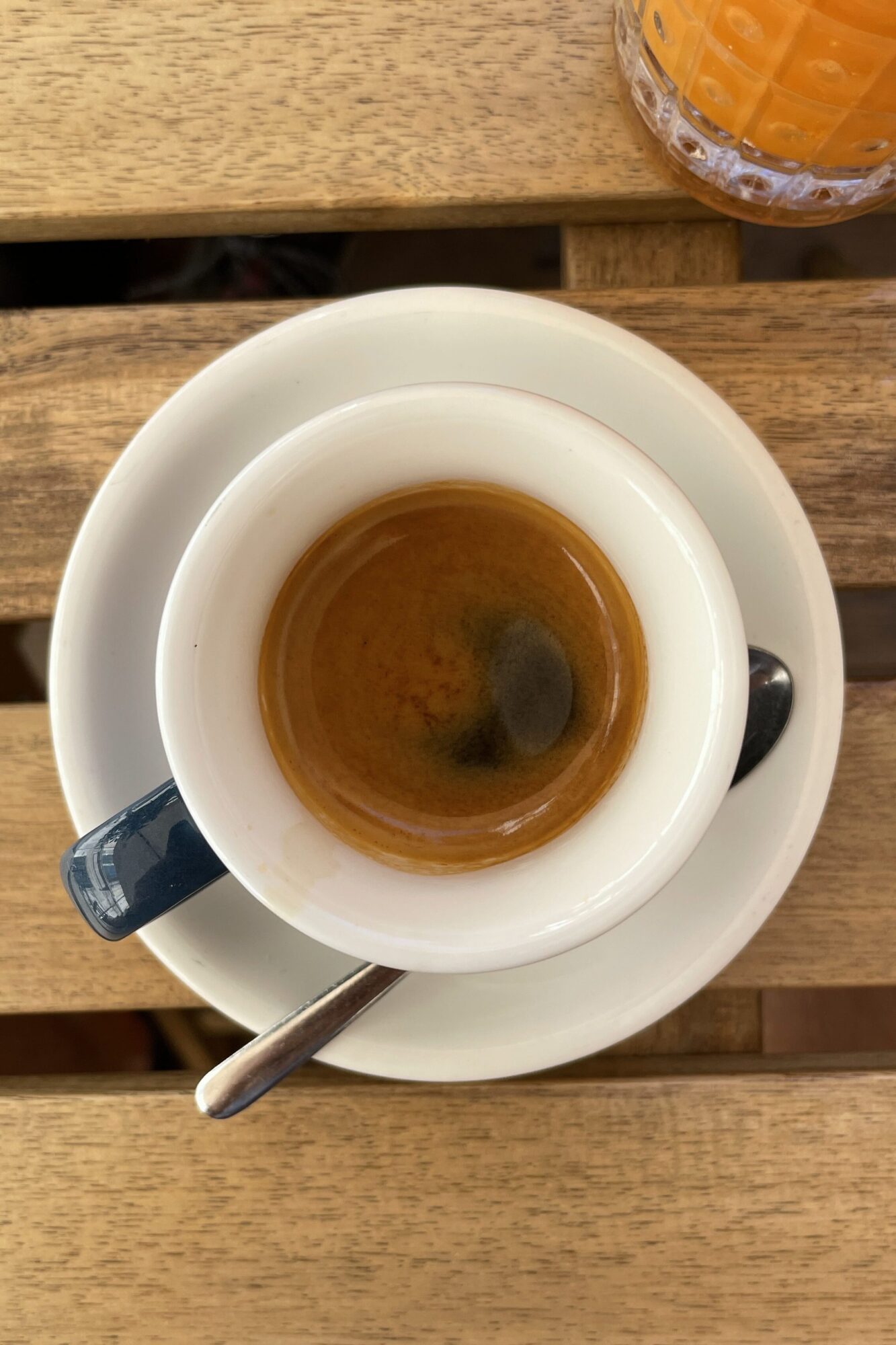
Pergamino Caffè
This is both the OG of specialty coffee in Rome, and also the best combination of location and quality. It’s a block or two from the Vatican, which makes it a perfect morning stop before your visit.
They have a bunch of Italy’s best coffee roasters – including both Gardelli (every Italian barista had this as their favorite coffee roaster in Italy, and I got a bag of a natural Ethiopian coffee that I loved) and Garage Coffee Bros in Verona (usually the second recommendation after Gardelli).
Barnum Caffè
A no-frills cafe near Campo de’ Fiori where you can get a nice espresso-based drink, either at the bar or on their cool little patio outside – or a cup of pour-over coffee featuring roasters from around Italy (including, when we were there, aforementioned Garage).
Fax Factory
This one is both my favorite of the three, and also by far the least convenient. It’s a 20 minute tram ride out into a more residential neighborhood that probably doesn’t make it onto the list if you have very limited time.
That being said, they have a great selection of both house-roasted coffee and coffee from around Europe available to purchase or order as a pour over. Which is my jam, and I loved being able to ask what the barista (owner?) recommended if I liked something bright and juicy.
Devour Delicious GELATO Daily
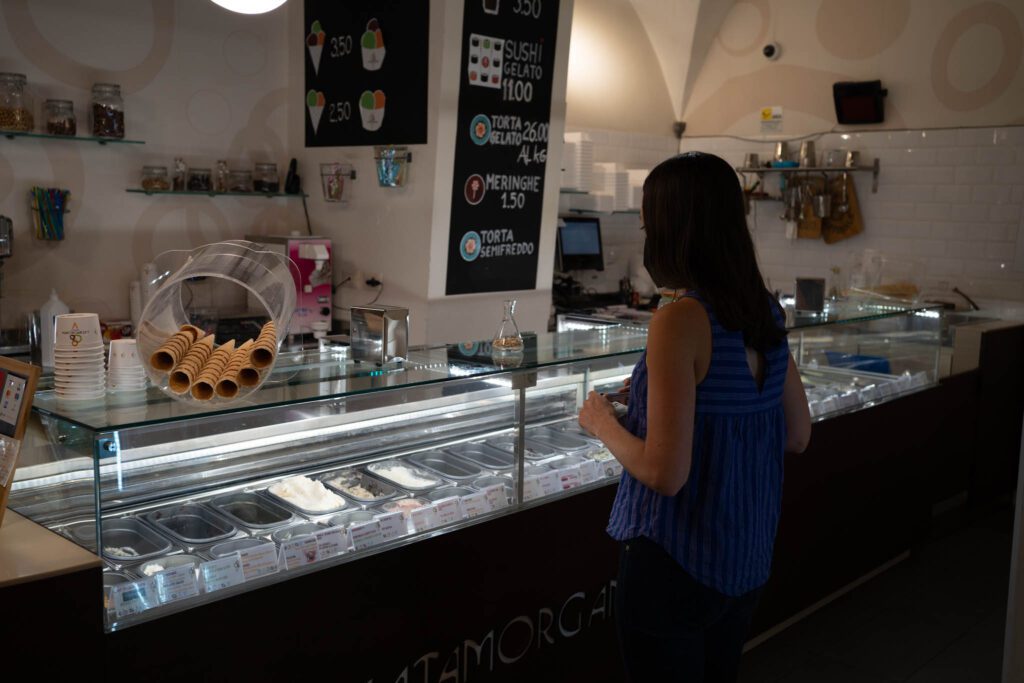
Now we move from Matt’s territory – coffee – to Alysha’s – gelato.
It’s really not all that surprising, but the gelato with super bright colors that is spilling out of the tubs outside the shop near Trevi Fountain is, unsurprisingly, not the best you can find.
The main takeaways are to look for gelato that is, best-case scenario, kept in a covered stainless steel container. Next best is gelato that isn’t heaped high into a container, because it’s bad for the gelato to be exposed to oxygen and heat.
Another thing to look out for is excessively bright colors. A good example is pistachio gelato, which is among our favorite things on earth. If the pistacchio gelato is a bright neon green, rather than a dull greenish-brown (which is what pistachios actually look like), then it probably has some unnecessary stabilizers and colors involved.
In general – and this is a generalization and isn’t strictly universally true – the closer you are to Trevi Fountain, the worse the gelato is going to be.
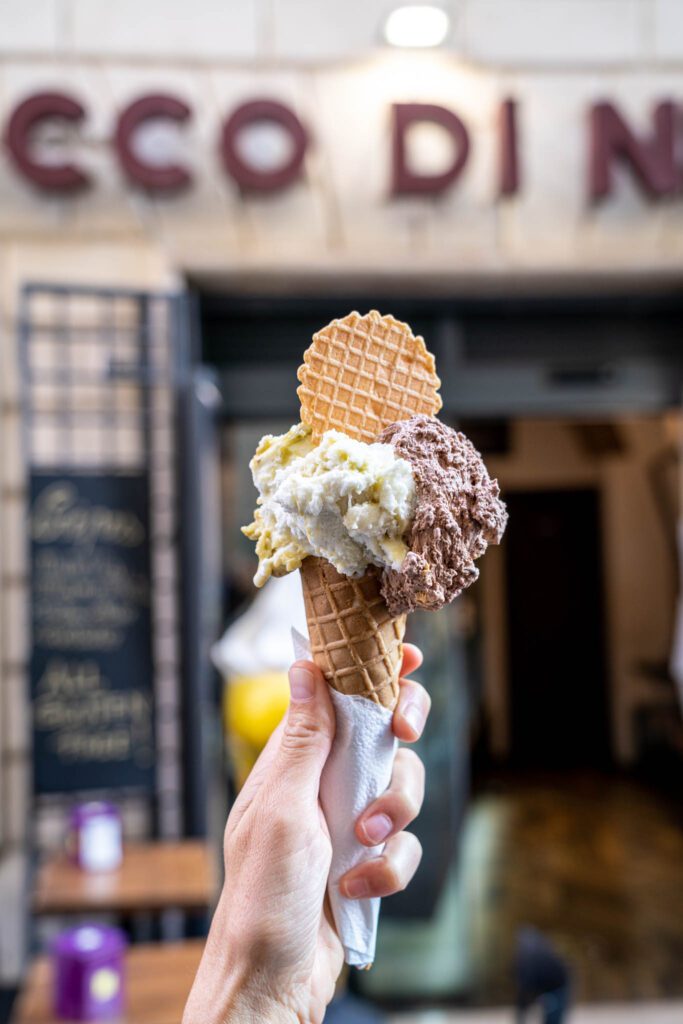
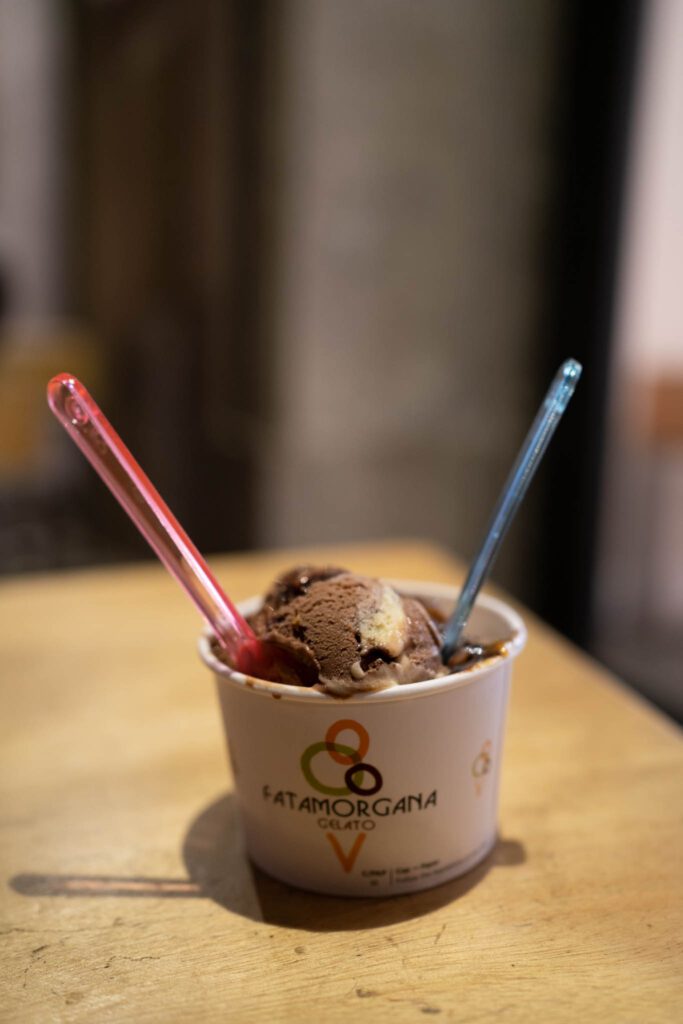
Here are three great gelato spots in the center of Rome that we loved!
Grom
Covered stainless steel containers! We absolutely love Grom – partially because everything, including cones, is gluten free – and we’ve been to their locations all over the world (including Lisbon and New York City).
Their pistachio is to die for, and they usually have a few seasonal flavors that are worth trying.
They have several locations in Rome, but the one we found ourselves going to is at the north end of Piazza Navona (here on Google Maps).
Fatamorgana
Another classic, we first experienced Fatamorgana in Los Angeles before finally making it to their locations in Rome itself.
They have a bunch of flavors that are constantly changing, and use fresh seasonal ingredients wherever possible. They had a location around the corner from our apartment on our first stint in Rome, and we went multiple times (“is it gelato time?” we would ask each other).
Everything, including cones, is gluten free, but you’d never guess.
Frigidarium
Just off of Piazza Navona is Frigidarium, which Alysha remembers because it is right around the corner from her school that she went to when she studied abroad in Rome.
The constant line out the door tells you everything you need to know. It’s not the best gelato in Rome, but it’s solid and the location can’t be beat (note: no gluten free cones here).
Dive into the World of Italian Wine
Over the course of our Italy itinerary, which lasted just about six weeks and was focused on Rome, the stretch between Milan and Florence, and a Sicily road trip, we tried a lot of wine.
The interesting thing about Italian wine is that there are a nearly unlimited number of different grape varietals in Italy.
We’re from Northern California, so we’re not strangers to wine (though we’re not wine people – we much prefer cider). However, here in California, you’ll find maybe 10-12 different varietals. Mostly, you’ll find about five or six.
In Italy, there are around 350 different varietals! Which is nuts.
Rome is a part of the Lazio wine region, known for its white wines. But Rome is the kind of city where you can find wine from all over Italy, if you know where to look.
When in Rome, you should drink good wine. And our favorite wine in Rome came from Enoteca Il Piccolo, a charming little wine bar in the Centro Storico known for a rotating selection of natural wines from local producers.
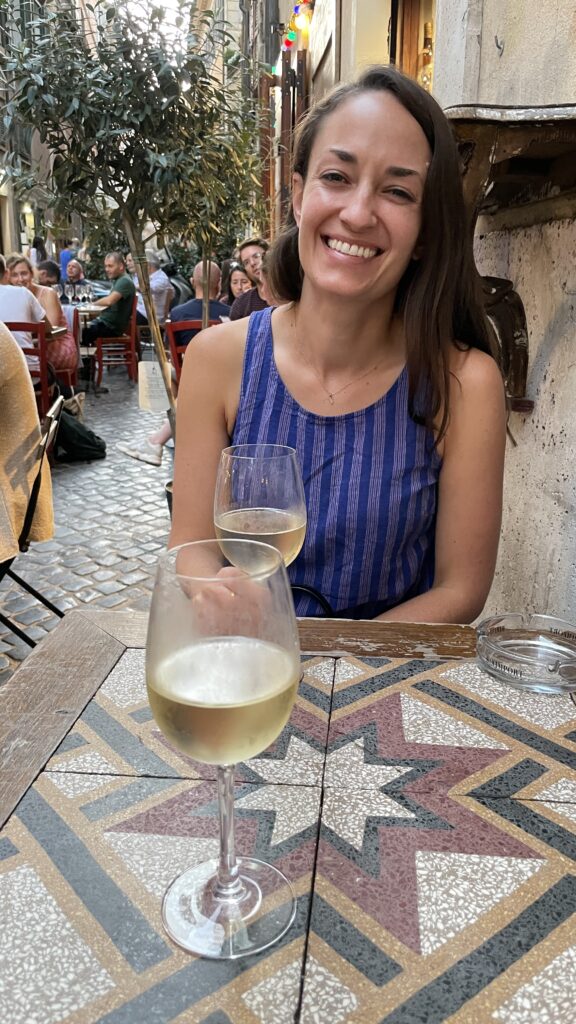
Not only was the wine – specifically a pet-nat, lightly bubbly white wine – great, but the experience was unique too! For context, we speak minimal Italian – enough to get by, order food, and pay, but that’s about it.
I attempted to describe, in Italian, what kind of wine I wanted (Alysha went straight for the bubbles – CLASSIC!), and it was a little bit of a disaster. An older gentleman, who I believe was the owner, was helping me, and he took my attempt, turned around, left, and brought me back a great glass of wine that perfectly matched what I was hoping for. All with about ten words spoken between us.
They have a nice little terrace outside that is a great place for a glass of wine on a warm afternoon, and sell wine by the bottle if you want to get one to enjoy later.
We also stumbled upon a great little wine shop over in Trastevere (who also had an excellent cider and beer selection) called Les Vignerons. It’s much more about bottles to go, but it’s a cool stop if you’re looking for some nice bottles of wine, beer, or cider to enjoy back at your hotel or apartment.
Pro-tip: Unlike our experiences closer to home, the house wine in Italy is generally both cheap AND excellent. When in doubt, get the house wine.
Take in the Best Views in Rome
There are endless places to get a nice view in Rome, some of which we’ve already covered (like the dome of St. Peter’s Basilica, or the terrace on top of Castel Sant’Angelo.
Here are a few more spots in Rome – some of which we stumbled upon mostly by accident – where you can get some excellent views out over the city of Rome.
Terrazza del Pincio
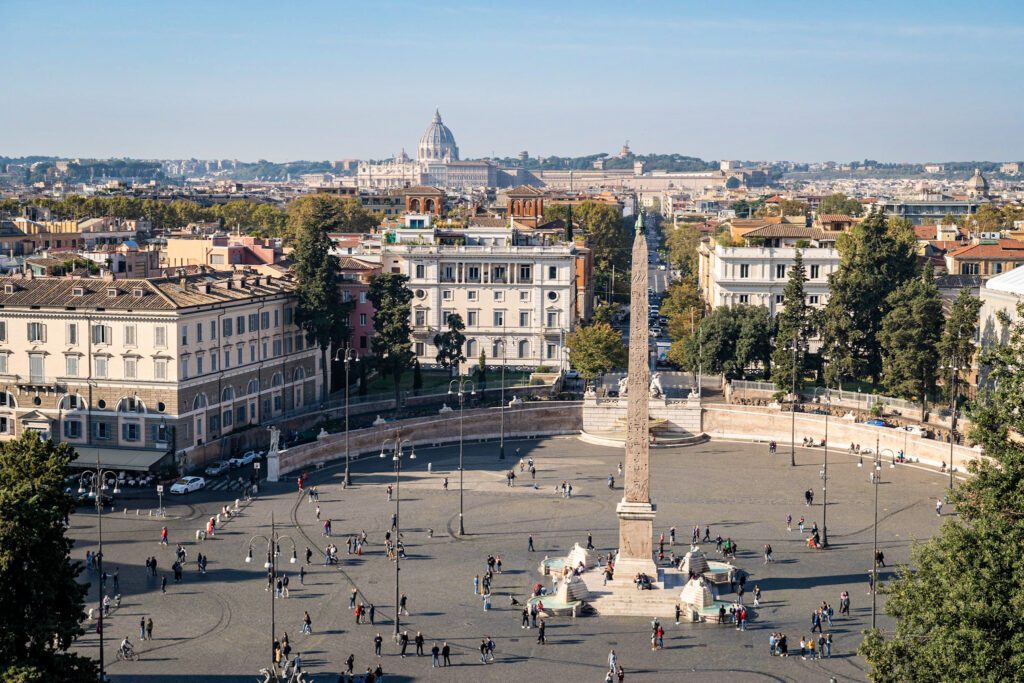
At the southwestern end of the Villa Borghese you’ll find this excellent viewpoint out over Piazza del Popolo, with the Flaminio Obelisk in the foreground, and the Vatican out in the distance.
It’s best in the morning, otherwise the sun will be right in front of you and wash out your photos.
You’ll find it here on Google Maps.
Terrazza Piazza Garibaldi (up above Trastevere)
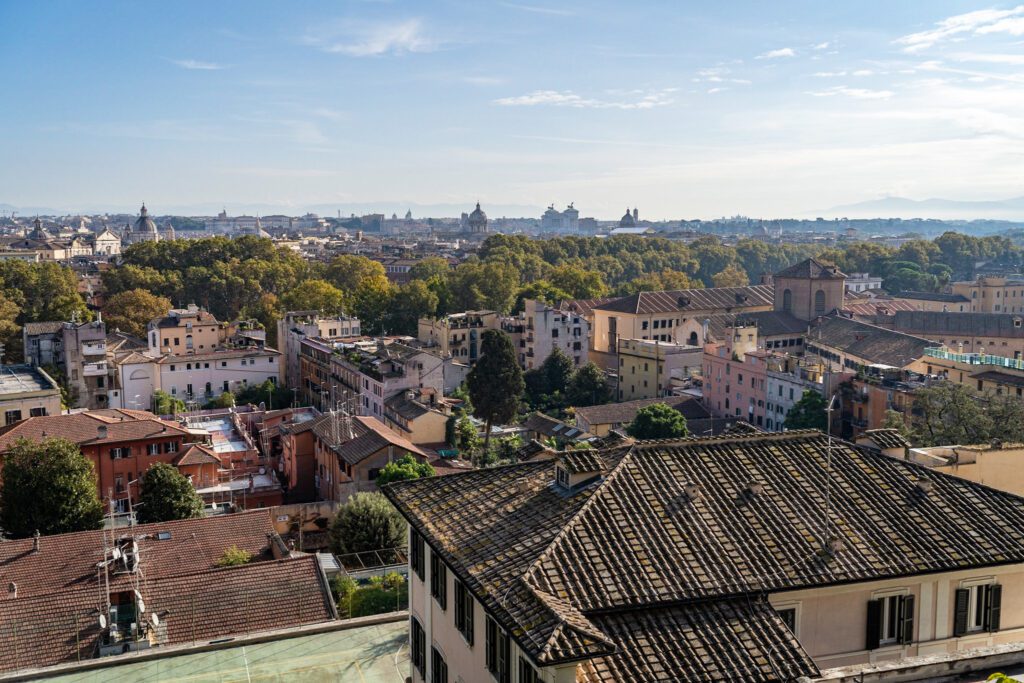
We accidentally came across this viewpoint as we went on a little bit of a wander up the hill above Trastevere. As you ascend the hill, there’s a bunch of history around the war for Italy’s independence that we really enjoyed.
We always forget that, despite being home to the Roman Empire, Italy is actually one of the newest countries in Europe.
You can take a nice walk from Trastevere up the hill and down to Castel Sant’Angelo and the Vatican. You’ll find it here on Google Maps.
Giardino degli Aranci (The Orange Garden)
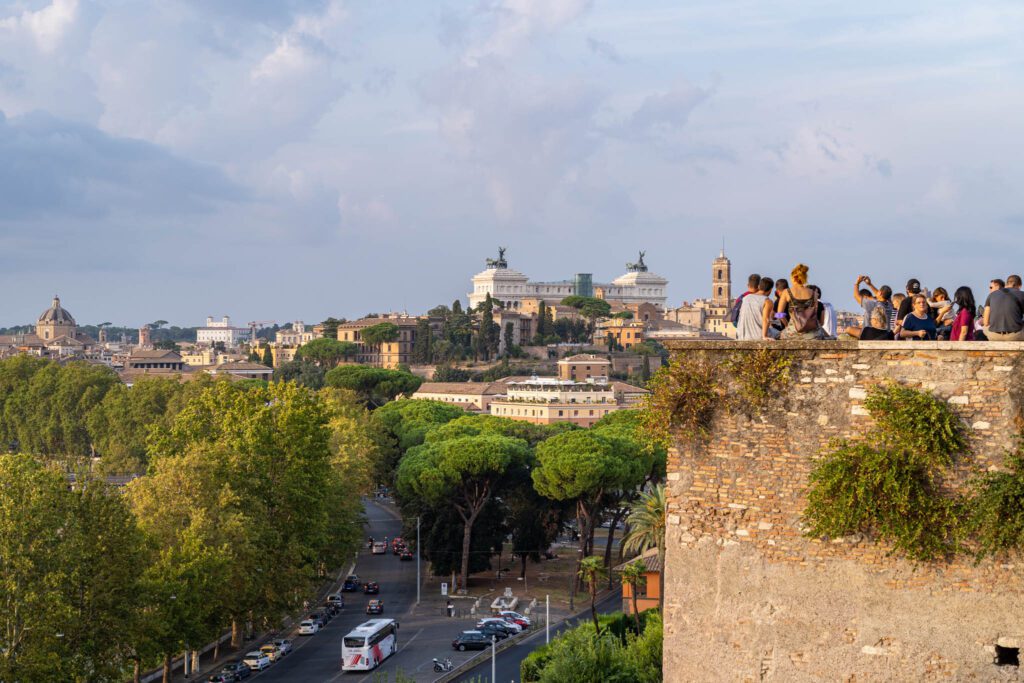
Our favorite sunset spot in Rome, but also everyone else’s too. It’s a lovely little terrace up on the hill where you can get a nice view of Rome from above, which will help you realize that despite walking around the historic center, Rome is not actually really that flat.
The best view is to the north, where you’ll have a view of the Tiber (it’s a little hard to see the river itself, but you can see its path) with the “wedding cake” (as Alysha calls the Monumento Nazionale a Vittorio Emanuele II) towering above the rest of Rome.
You’ll find it here on Google Maps.
The Keyhole
This is right down the road – a few hundred feet away – from the Orange Garden. First thing’s first – everyone and their mother comes here for a picture in the late afternoon around sunset.
You can see the line in the picture below (we skipped it and came back in the early morning, when we were literally the only people there).
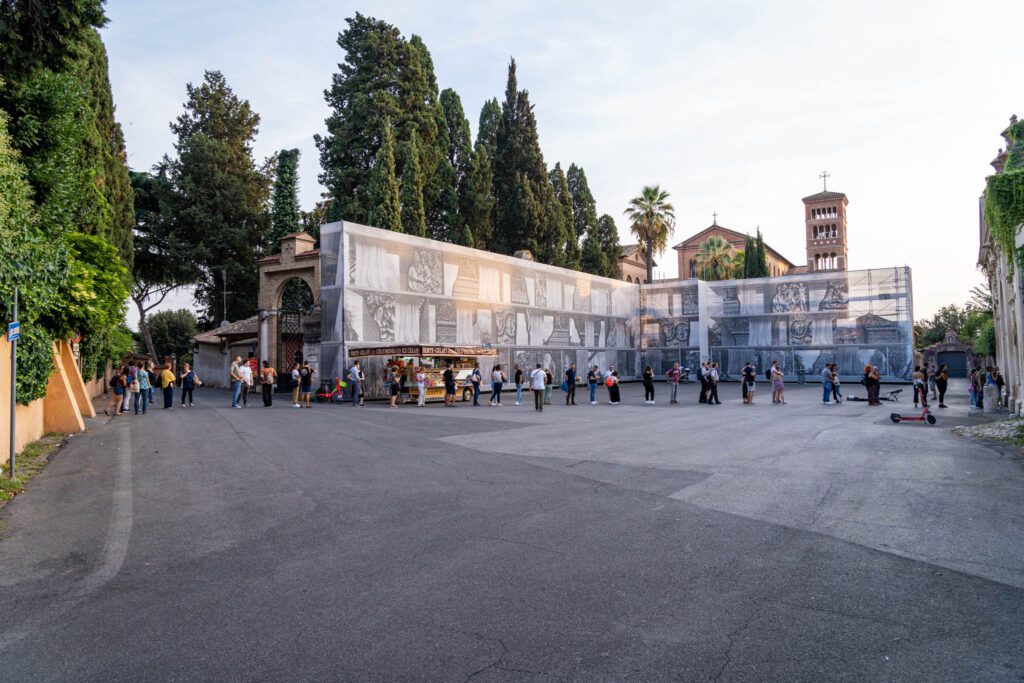
Someone expertly designed and placed the door and its keyhole here to have a picture-perfect frame of the dome of the Vatican when you look through it.
You’ll find it here on Google Maps.
The Roman Forum from Above
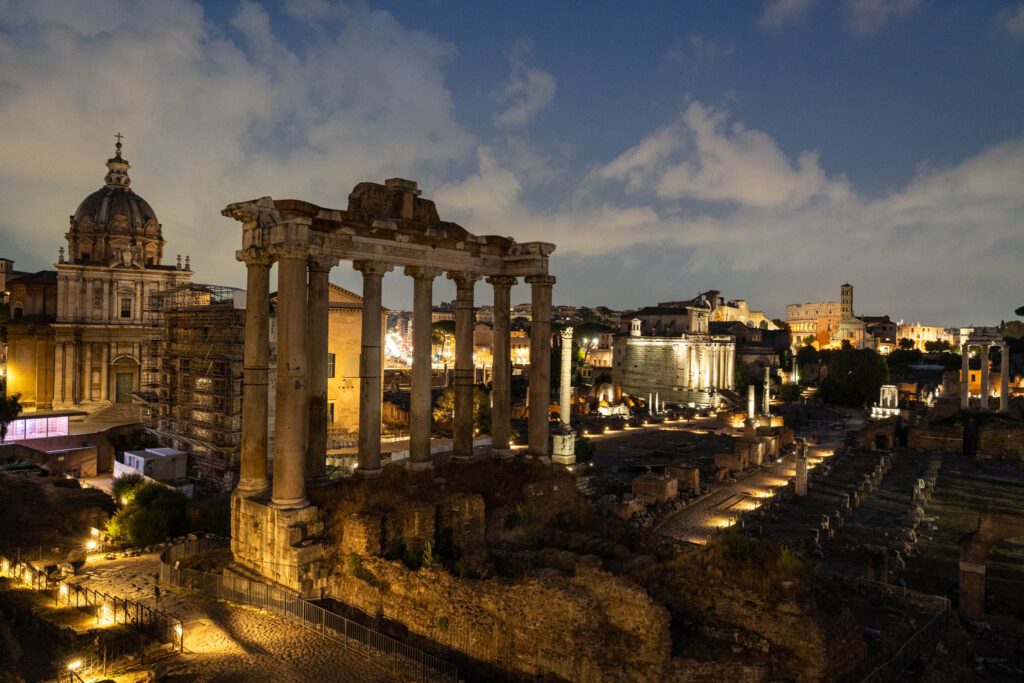
I’m not sure if this viewpoint has a name or not, but we stumbled upon it during a post-aperitivo walk back to our apartment. From here, you have an excellent view out over the Roman Forum.
It’s best in the afternoon and at night, when the sun isn’t directly across the Forum from you.
Planning a trip to Italy? We’d love to help!
Here are our other Italy travel guides to help you plan an incredible trip (even if you have to eat gluten free!).
If there’s no link below, it means we’re still working on it – long, in-depth guides take time! We’re working on it, though, we promise.
If you’re planning a trip and you’re not sure where to start, your first stop should probably be one of our detailed itineraries.
We have a two week Italy itinerary that blends the main cities with some less-visited cities that we love (BOLOGNA!), a guide to spending 10 days in Italy that focuses mostly on the highlights, and a whirlwind guide to spending one week in Italy that features the Rome – Florence – Venice highlight circuit.
Here are more specific guides to the main cities in Italy.
Rome
- How to Plan an Amazing 4 Day Rome Itinerary
- Where to Stay in Rome: A Complete Guide for First Timers
- 12 Things to Know Before You Visit Rome
- Gluten Free Rome: A Complete Guide to GF Restaurants + Bakeries
- Where to Find the Best Specialty Coffee in Rome
Florence
- What to do in Florence (as a First Timer)
- How to Plan an Amazing Florence Itinerary (3 Days)
- Where to Stay in Florence: A Complete Guide for First Timers
- Gluten Free Florence: A Complete Guide to GF Restaurants + Bakeries
- Where to Find the Best Specialty Coffee in Florence (for Coffee Nerds)
- The Best Day Trips from Florence (Complete Planning Guide)
Bologna
- What to do in Bologna (as a First Timer)
- How to Spend One Incredible Day in Bologna
- How to Plan an Amazing Bologna Itinerary (2 Days)
- Where to Stay in Bologna: A Complete Guide for First Timers
Cinque Terre
- What to do in Cinque Terre (as a First Timer)
- How to Plan an Amazing Cinque Terre Itinerary (2 Days)
- Where to Stay in Cinque Terre: A Complete Guide for First Timers
Milan
- What to do in Milan (as a First Timer)
- How to Plan an Amazing Milan Itinerary (2 Days)
- Where to Stay in Milan: A Complete Guide for First Timers
- Gluten Free Milan: A Complete Guide to GF Restaurants + Bakeries
- Where to Find the Best Specialty Coffee in Milan (for Coffee Nerds)
The Rest of Italy
